




















Traverse City Office 236 1/2 E. Front Street, #26 Traverse City, MI 49684 231-943-6988
Main Office 5931 Oakland Drive Portage, MI 49024 269-385-5888 or 888-777-0216
• We uphold a Fiduciary Standard and work with clients on a fee-only basis.
• We do not receive commissions, kick-backs, or soft dollars from product sales, eliminating inherent conflicts of interest.
• Our team of professionals holds designations and degrees such as CFP®, CFA, CPA, MBA, JD, and PhD.
• Charles received his MBA from the Kellogg School of Management - Northwestern University, his MA in Economics from WMU, and Executive Education from Harvard Business School and Columbia University.
Charles Zhang, CFP®, MBA, MSFS, ChFC
• Ranked #1 on Barron’s list of America’s TOP Independent Advisors for 2024. Charles has achieved the #1 ranking three times within the past four years.*
• Ranked #4 in the nation on Forbes’ list of TOP Wealth Advisors and is the highest-ranking Fee-Only Advisor on the list.*


ATLAS Space Operations, a Traverse City-based technology company that provides Ground Software as a Service (GSaaS) solutions for satellite communications purposes, is in the process of getting acquired by a major defense technology firm. The acquisition will play into a potentially revolutionary national defense strategy called the “Golden Dome,” which is aimed at shielding the entirety of the continental United States from potential missile attacks. ATLAS Space Operations was founded in 2015, and relocated from California to Traverse City in 2017. Last month, the Denver-based York Space Systems issued a press release announcing that its parent company was in the process of buying ATLAS to “strengthen York’s position as a fully integrated space solutions provider for national security and commercial missions.” The Golden Dome is a defense initiative brought to the fore by President Donald Trump.
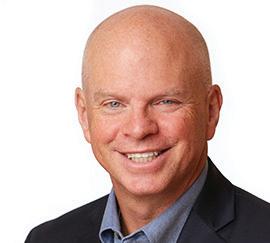
Promethient, Inc., a Traverse City-based innovator in human-scaled climate control solutions, recently announced that Penrose Partners has led the company’s Series B investment round. This infusion of capital will accelerate the commercialization of Promethient’s flagship Thermavance™ technology across multiple industries, including power sports, mass transit, stadiums, furniture and wearable applications. “Penrose Partners investment is a significant endorsement of our mission to revolutionize personal climate control,” said Bill Myers, Promethient CEO. Promethient has previously secured investments from Boomerang Catapult, the Northern Michigan Angels, Michigan Rise and the Michigan Outdoor Innovation Fund.
Gov. Gretchen Whitmer recently announced the initial eight recipients of the first-ever Michigan Innovation Fund (MIF), a $60 million appropriation
to distribute across existing evergreen venture funds in Michigan, emerging evergreen funds in Michigan, and others who contribute to the entrepreneurial ecosystem in Michigan, especially toward startup companies, founders and funds. Traverse City’s 20Fathoms received $1.6 million from the emerging evergreen funds - those organizations with a solid base of support but who are newer to the entrepreneurial ecosystem.

Nocturnal Bloom Brewing - Traverse City’s newest brewery - opened late last month in the Atomic Marketplace at 3344 Cass Rd. Owned by Justin Rivard, the brewery is using “hyper-local” ingredients and a botanical-inspired approach for its craft beer, cocktails, NA drinks, and more. The Atomic Marketplace is also home to the recently-opened Seismoto Coffee Bar, operated by Jolie Roth, with a variety of coffee, espresso and fresh-baked pastries. Also, Traverse City native Marivi Bryant recently launched HOME Agency, a firm that provides marketing solutions that prioritize people-first engagement. Marivi spent the last 15 years building campaigns for Fortune 100 brands. To celebrate the launch and as part of its commitment to making an impact in local communities, the company is offering a Values in Action Award, a $100,000 marketing services grant for one mission-driven nonprofit.
Learn more at wearehomeagency.com.
Other new business openings around the area include Southern Charm Consignment Boutique at 107 S. Brownson Ave. in Kingsley, Masala Magic by Anita at 115 Ames St. in Elk Rapids, candy and treat store Sweet Asylum at The Village at Grand Traverse Commons, and new barber shop Underground Hare at 502 East Front St. in downtown Traverse City.
A new fast-track pathway to registered dental assistant (RDA) certification is being offered by Northwestern Michigan College in Traverse City. Starting in January, current certified dental assistants (CDAs) can expand their career opportunities in as little as one semester. RDAs are able to perform more procedures
















independently than CDAs. Average base salary for a full-time RDA in Michigan is $37,140/year, according to the U.S. Bureau of Labor Statistics. The profession is expanding at a rate of 11% per year.
The Home Builders Association of Northwest Michigan recently announced the winners of the 2025 Parade of Homes Judge’s and People’s Choice Awards. In addition to public voting, all participating homes were evaluated by a panel of impartial industry experts who toured each entry to determine the winners in the following judged categories. This year’s entries were divided into two valuation groups: homes priced under $600,000 and those over $600,000. Over $600,000 Judge’s Award Winners include: Scott Norris Construction (Traverse City)- Best Interior, Best Exterior & People’s Choice; Greenwald & B.C (Mt. Pleasant) - Best Kitchen & Best Master Suite; Bay Area Contracting (Traverse City) - Best Craftsmanship & Judges’ Overall Choice. Under $600,000 Judge’s Award Winners include: Scott Norris Construction - Best Interior, Best Kitchen, Best Craftsmanship & Judges’ Overall Choice; CMB Construction (Traverse City) - Best Exterior; Leelanau Construction (Cedar) - Best Master Suite.

Up North Pride recently announced the location of its new temporary office, meeting space, and community center in the former home of Copy Central on Eighth Street in Traverse City. The property will eventually be converted into housing through the Traverse City Housing Commission, but in the meantime the organization and SBK Properties owners Sean and Blythe Skarshaug have partnered on the temporary home until the housing project is able to move forward. “After we came to agreement with the Traverse City Housing Commission, we knew
there would be a waiting period,” said Sean. “We felt that it would be a shame for a downtown building like this one to go unused during that window. It was important to Blythe and I that the space be used somehow in a positive way, and to find an amazing organization to give it life until the TCHC is ready for it. Up North Pride is the perfect fit.”
Venture North Funding and Development in Traverse City has received a $50,000 grant from the DTE Foundation to help small businesses in northwest Michigan. Funds will be used to provide rural businesses with low-cost loans and no-cost consultations to support their growth, with priority given to areas underserved by other financial institutions or to business owners with income at or below the poverty level.
AAA The Auto Club Group has relocated its branch office to 2322 U.S. 31 North in Traverse City. For more than two decades, AAA of Traverse City has served members throughout the Grand Traverse County region. The new location offers its full suite of services, including auto, home and life insurance, travel services, banking products, passport photos and international driving permits.

Housing North has launched the Housing Exchange Platform, a new regional platform that connects individuals seeking rental housing with local property owners offering rental units, accessory dwellings or shared living arrangements across northwest Michigan. The Housing Exchange is a free, community-based tool developed in response to the ongoing housing challenges facing the region. “We regularly hear from residents, employers and seasonal workers searching for housing and from property owners who want to help but don’t know how,” said Yarrow Brown, executive director of Housing North. “The Housing Exchange bridges that gap by offering a centralized space where rental opportunities and people in need can connect.”















In Traverse City, we talk a lot about the eat-and-drink economy — and rightly so. It’s delicious, it’s resilient and it’s deeply ours. Restaurants, wineries, breweries, farms: They make up the flavor of the region and are woven into our sense of place.
But if we zoom out for a moment, there’s something else quietly growing here that deserves a seat at the table: the arts. Not just the live band at your favorite tasting room or the string quartet at a wedding, but a larger vision — one that sees the arts as part of our town’s longterm infrastructure, right alongside food, wine, and nature.
As Board President of the Traverse City Philharmonic, I’ve had the privilege of witnessing firsthand the bold, vital work happening through our new Community Music School, now entering its second year and already making a positive impact across our region. The mission remains the same: to ensure every child here, regardless of income or background, has access to quality music education. Real instruments. Real lessons. Real mentors. A chance to learn, to perform and to be part of something bigger than themselves.
And while board meetings often revolve around budgets, planning and strategy, the moments that stay with me are the small glimpses of why this work matters: seeing a child walk past the conference
COMMENTARY BY SEBASTIAN GARBSCH
Investing in the Traverse City arts community drives civic strategy
room window, violin case in hand, eyes bright with the anticipation of learning something new that day. It’s a reminder that we’re not just building an organization; we’re helping to build confidence, discipline and a lifelong love of the arts in the next generation.
Why does this matter in a magazine issue focused on real estate and invest-
Opera House, shares that live arts are a “vital” part of any civic strategy.
“Every cultural institution relies on community understanding and support – ticket sales cover just a fraction of our costs, so we’re deeply grateful for the generous gifts and goodwill that keep the arts alive in Traverse City,” he said. “Live arts, in particular, are a vital part of any civic
Investing in the arts is an investment in our entire community. It’s economic development in disguise. It’s retention. It’s tourism. It’s what helps people decide to stay, to build, to raise families and to grow businesses here. A vibrant arts community isn’t just “nice to have” — it’s part of how a place becomes magnetic.
ment? Because investing in the arts is an investment in our entire community. It’s economic development in disguise. It’s retention. It’s tourism. It’s what helps people decide to stay, to build, to raise families and to grow businesses here. A vibrant arts community isn’t just “nice to have” — it’s part of how a place becomes magnetic.
And it’s not just TC Philharmonic.
Chad Lindsey, Executive Director of City
EDITORIAL &
PUBLISHER
Luke W. Haase lhaase@tcbusinessnews.com
CONTRIBUTING EDITOR
Gayle Neu gneu@tcbusinessnews.com
HEAD WRITER
Craig Manning
STAFF WRITER
Art Bukowski
CONTRIBUTING
Kierstin Gunsberg
COPY
WEB
DISTRIBUTION Marc Morris
SERVING
Grand Traverse, Kalkaska, Leelanau and Benzie counties
strategy, driving commerce and foot traffic to places like our beloved Front Street.”
Paul Jarboe, president of Old Town Playhouse and vice president of the Traverse City Philharmonic, emphasizes the power of community partnerships this summer as the Playhouse kicks off its 65th anniversary season with “The Prince of Egypt” at the Milliken Auditorium, running August 21-23.
“Our need this year is community awareness and support,” he said. “We’re reaching out for underwriters and volunteers to help with this one-of-a-kind production.”
All of us are working toward the same vision: a Traverse City where the arts and live performances are not just surviving, but thriving. Just as a chef needs farmers and a vintner needs a trellis, a great town needs its artists, its stages and its creative spaces – and a plan to keep them alive for the next generation.
So, as you raise a glass to the last stretch of summer, consider what it means to build a city where creativity and culture are part of the foundation. Support a local performance. Volunteer. Sponsor a student’s lessons. Bring friends to a performance. Show up for your community. If you’re curious how to help, get involved or simply stay in the loop, reach out to any of these three amazing organizations — or countless others in our community working to keep the arts alive. We’d love to hear from you.
Sebastian Garbsch founded Formative Fitness after graduating from Ferris State University with his bachelor’s in business. He is the owner of Blue Goat Wine & Provisions and is currently serving as president of the Traverse City Philharmonic, as well as on the board of TC Tritons Rowing.
AD SALES
Lisa Gillespie lisa@northernexpress.com
Kim Murray kmurray@tcbusinessnews.com
Kaitlyn Nance knance@northernexpress.com
Abby Walton Porter aporter@northernexpress.com
Michele Young myoung@tcbusinessnews.com
COVER
Megan Renae Studios
Periodical
POSTMASTER: Send
to
MI



Welcome to the KEEN Corner!
In the heart of downtown Traverse City, you’ll find this hidden gem amongst the busy streets of Front and Cass Whether you want to dance, celebrate, or unwind, the KEEN Corner is here to make it happen
The Pub:
Located on the ground floor, The Pub is a cozy neighborhood favorite where locals gather over pints of Guinness, classic pub fare, and the occasional traditional Irish music session With a welcoming atmosphere and timeless charm, it’s also a go-to spot for catching the game or joining in on lively entertainment like karaoke and music bingo.
North Bar:
Upstairs from The Pub, North Bar offers a chic rooftop experience in the heart of downtown Traverse City The space features a tropical-inspired ambiance and a signature greenhouse-style roof with remote-controlled panels, creating a year-round open-air vibe With panoramic views of the city and peeks of the bay, it transforms into a high-energy cocktail lounge by night , often featuring live music and a vibrant crowd
The Dune Room:
Tucked within North Bar, The Dune Room is a stylish private event space ideal for gatherings of up to 60 guests Designed with flexibility in mind, it’s perfect for everything from intimate dinners to celebratory receptions For larger occasions, full buyouts of North Bar can accommodate up to 240 guests, offering an unforgettable setting with skyline views and an energetic, upscale atmosphere.
The KEEN Suites:
These condos are just steps away from Traverse City's vibrant Front Street. No need to drive to enjoy the best dining and shopping TC has to offer Put your feet in the sand at the best beach in town less than 2 blocks away! You'll find everything a family or group of friends could need to enjoy a fabulous getaway in TC!
Scan the UR Code below to view our airbnb listing on the Keen Corner website or check us out at www thekeencorner com

Eleven:
A boutique in Traverse City, MI Focusing on women ' s designer fashions, expressive accessories, and inspiring decor. The pieces are sourced thoughtfully and chosen with special attention paid to quality textiles and originality.

By Art Bukowski
Leah McCallum is a familiar face around town. While she still runs her consulting business (Blue Orange Consulting, named for the two colors that blend in those fabulous Great Lakes sunsets), she’s also a public engagement specialist with the Great Lakes Fishery Commission. In this role she’s a champion of FishPass, an ongoing project on the Boardman/Ottaway River. She’s on the go almost all the time and set up her desk for this feature on a table overlooking the FishPass construction site. Thanks, Leah!


1. Everything I do is for this community and Great Lakes focused adventures, and that means that I’m not at a desk 99% of the time. I do almost everything from my phone. Thank God we live in an era where I can do most of my job from a little device in my butt pocket.
2. This is a model of a sea lamprey. The Great Lakes Fishery Commission exists in part to keep those bad boys from doing too much havoc on the Great Lakes.
3. That’s just a reminder that if you put in a little time, things can change. I had a pretty jacked up smile for a good chunk of my life.
4. For 12 years of my life, I was on the Downtown Development Authority board of directors. It’s the only time in my life I’ve had a nameplate, and it made me laugh. Kind of old school and feels a little official, so I kept it.
5. This is Short’s Thirst Mutilator. It’s really a delicious alternative to soda. No sugar, tastes great, very refreshing. And mutilator is an underused word that I wanted to weave into this conversation.
6. Over the last year, my husband and I have gotten really into tinned fish. They’re a delicious source of
protein. They’re so tasty and we eat them all the time. For Father’s Day, I got him a very large mixed box of tinned fish – many different varieties. I have them all over my house and my life because we eat them so often.
7. My sweet boy Harvey learned how to weave at summer camp and made this for me. He’s had a lot of firsts this summer, and this is evidence of them. I’m proud of him.
8. I like to collect brass things that make noise. I have a shelf in my kitchen and in my home office. Dinner bells, things that get people’s attention. They age well, they’re artifacts, and I just think they’re pretty.
9. I just had a lovely weekend on Mackinac Island with my daughter Daisy. We went to the Pink Pony, and she got this for our dog. It’s a dog bandana. So even though she got things for herself, she thought of our sweet golden retriever.
10. FishPass, a first-of-its-kind river connectivity and restoration project, will be fully operational by 2027. All in-stream/wet work will be done next year, with upland/dry work (amphitheatre, education building, native plants/trees) to follow in 2027.
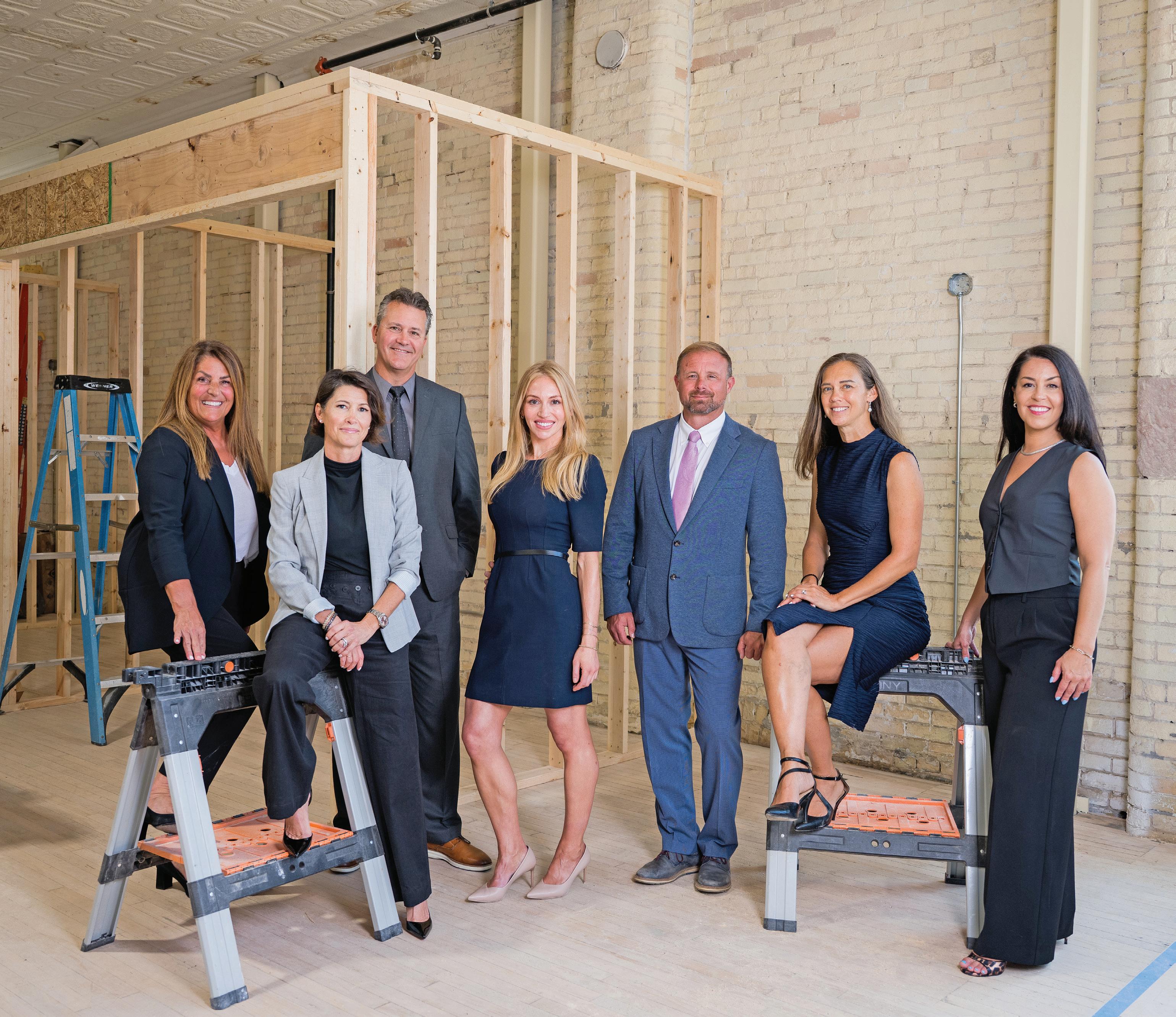
Molly Buttleman
Shannon Beia
Ken Kleinrichert
Lydia Wiley
Ryan Craig
Jenni Craig
Erika Nita
By Art Bukowski
Real estate agents change brokerages all the time. No big deal. You might even argue that where they are is irrelevant, especially considering how much of their work is built on personal branding and individual relationships.
Still, more than a few heads turned when a new office managed to attract several familiar and high-performing local agents in a matter of months. It helps that this office will be located in the heart of downtown in a prominent building that’s in the process of getting one heck of a facelift.
The full, formal name of this office is somewhat of a mouthful: @proper-
ties REMI Christie’s International Real Estate. Those tied to it are fond of just saying Christie’s, the very same brand known around the world for its high-end auction house.
It was a chain reaction of sorts that took a brand known around the world and plopped it right at Union and State streets in the former Cousin Jenny’s building. The TCBN takes a look at this new office and its agents as they settle in.
London to Union Street
Not long after the COVID pandemic, Traverse City native Lydia Wiley came back home after time spent in Chicago’s
bustling real estate market.
While in Chicago, however, she became familiar with a Chicago-bred brokerage known as @properties, which grew in a few short years to dominate that market. Though she didn’t work for this company, she was consistently impressed with its operations.
“They were always very tech-forward, and they always had the very best reputation,” she said. “Agents were very happy there, and I always respected them as a brokerage.”
Back in Traverse City, she joined RE/ MAX for a little while, though she hoped to eventually open a “boutique luxury brokerage” in Traverse City. Even though “luxury” can be such a cliché in the real

estate world, she felt the local market was missing the high-end firms she was familiar with in Chicago.
“It doesn’t even necessarily have to do with price point,” she said. “It’s just that extra touch.”
Meanwhile, @properties purchased Christie’s International Real Estate (which has 10,000 agents across more than 100 brokerages and at least 50 countries) in 2021. That led to a Michigan-based affiliate, @properties REMI Christie’s International Real Estate, which opened several offices in metro Detroit before deciding to branch north.
Wiley joined the new company in 2023 and was the brand’s only Traverse City representative, though there was an office in Petoskey. When it was clear that a Traverse City office was in the cards, she kept an eye out for the right partnership to make it happen.
This partnership eventually material-
ized with luxury real estate development firm Freshwater Development. The company, founded by New York developer Andrew McCarthy in 2021, has made a name for itself quickly, thanks to high-profile redevelopment projects like the former Cousin Jenny’s building or what used to be the Dingeman & Dancer law offices on Park Street.
Both buildings are being redeveloped into luxury condos, with ground-floor space reserved in the former Cousin Jenny’s for the new @properties REMI Christie’s office. Finishing touches are underway and the team expects to move in this month.
Spreading the word
Meanwhile, Wiley spread the word looking to attract agents to the new office. Not just any agents – the cream of the crop.
“I wanted to curate an office with the best agents,” she said. “Start with great


people and let it work out naturally from there.”
This is in line with a model the company has stuck to as it has opened its 11 offices across the state.
“We have a similar approach in every market we go into where we look at the top agents production-wise, but also who’s really involved in the community,” owner Eric Walstrom said. “Who are going to be the people who are going to turn some heads and are great individuals who can lead the charge?”
Walstrom is thrilled with the Traverse City team so far, which combined has more than 70 years of experience and $100 million in sales in 2024 alone. Beyond that, they are the familiar faces that the brand craves.
“In terms of people, it’s probably one of the best markets we’ve opened in the past four or five years,” he said.
Agents that have come to Christie’s








tell the TCBN that a variety of factors led them to make the jump to the new company. The technology and tech support is fantastic, for one, something that @properties has always focused heavily on.
“I’m in luxury, and I need forward-thinking when it comes to technology. I use tools. And I needed a brokerage that was going to support the level of client I have,” said Molly Buttleman, a perennial top agent who left Coldwell Banker Schmidt to join Christie’s.
And then there’s that name. That brand.
“When you get a brokerage like Christie’s that emulates luxury, that elevates whatever you’re doing with your own brand,” she said. “It helps me elevate myself.”
This is a sentiment shared by fellow Coldwell Banker expat Shannon Beia.
“I think it’s a huge [boost] for us when someone is looking and they see we’re an agent with Christie’s,” she said. “[The company] saw enough to want to put their
best of both worlds,” he said. “So now you’ve got the high-end properties, but you still have that back office with the technology, the energy, the systems.”
But he also feels that Christie’s steps to bring on quality agents also amounts to “attraction marketing” in its own right, as good agents want to work with good agents.
“[Owners Walstrom and Alex Irrer] are about building relationships, and their
level of experience. They follow through. They’re conscientious. They have character. They’re doing extra things.”
“Collectively, we’ve all worked at a certain level, we’re selling at a certain price range and certain caliber, and now we’re all at the right office,” Beia added.
Not all agents are cut out for Christie’s, these agents stressed. There’s definitely an invite-only vibe.
“We have a similar approach in every market we go into where we look at the top agents production-wise, but also who’s really involved in the community. Who are going to be the people who are going to turn some heads and are great individuals who can lead the charge?”
– Eric Walstrom, Owner, @properties REMI/Christie’s International Real Estate
“Christie’s level is just [higher] in terms of tools, technology, luxury, and frankly keeping the eyes on the prize with a very supportive, young and forward-thinking staff,” Buttleman said. “All of that was important to me for my final years, whatever that might be. At the end of the day, it’s all about the energy of this company.”
Kleinrichert and Beia (who calls Christie’s a “breath of fresh air) both spoke about rediscovering their passion for real estate at Christie’s after becoming jaded over time.
“Having worked with Ken Schmidt over the years, I knew what it was like working with someone who really had their heart in it, and I saw in these guys what Ken had,” Kleinrichert said. “The elephant in the room is I didn’t feel like that anymore where I was at ... and I saw something in this company that reminded me of why I was in real estate.”
The team as assembled is not likely to grow a whole lot larger anytime soon, but



Build a welcoming, ‘up north lodge’ community center for a new manufacured housing development.
Burdco interpreted and fulfilled my greater vision for this building amidst major challenges, including design constraints, budget limitations and product shortages. Burdco executed the plan smoothly. The client communications were excellent. The details and workmanship are impressive and set a positive tone for the entire development. ”

By Art Bukowski
Many real estate agents will tell you there’s no greater joy than getting their clients to the finish line.
Whether they’re buying or selling, the process for a client can be long, arduous and time-consuming. Signing that giant stack of closing documents is almost always a cause for relief, satisfaction and celebration.
It’s at or around this time that many agents provide a closing gift of some sort to their client. It’s a way to celebrate the occasion while thanking the client for hiring them.
There’s no right or wrong method when it comes to these closing gifts. They can range from inexpensive to quite pricey. Some agents customize gifts for each individual client, while others get the same for everyone. Certain agents prefer gifts that are permanent additions to the home, others prefer food, drink or experiences.
All agents the TCBN spoke with tend to customize their gifts depending on the client, some after trying a standard gift and finding out that it just didn’t work.
“For me it’s kind of evolved from trying to be somewhat systematic to having
Real estate agents seal deal with thoughtful closing gifts
“For me it’s kind of evolved from trying to be somewhat systematic to having it be a curated process for each client individually … so it feels very personal.”
- Aubrey Vandemark, The Mitten Group.
it be a curated process for each client individually … so it feels very personal,” said Aubrey Vandemark, an agent and associate broker with The Mitten Group.
In her earlier days, Vandemark got clients a big Yeti cooler loaded with fun stuff. And while those were appreciated, they started to feel a little too cookie-cutter, especially after spending so much time with these clients.

“We’re really trying to personally curate each gift, because this is such a journey and we get to know these people during the biggest transactions of their lives,” she said. “So for one family it might be a night at the Great Wolf Lodge, or for an older gentleman from Greece, he got a lot of things that made him feel [at] home.”
Nan Ray, an agent at Century 21

Ray
Northland, also finds that these gifts simply have to be personalized.
“I’m always trying to be more efficient, so I’ve tried standardizing it so many times, but I’ve learned it just doesn’t work,” she said. “As much as I want to say that everyone gets a trio of beautiful champagnes from The Blue Goat, then you run into nondrinkers or people where that goes against their value sys-

tem, or [you worry] they won’t think it’s thoughtful enough.”
In recent years, Ray has settled into a “get to know your neighborhood” gift package that’s customized to their locale, often with items from and gift cards to local businesses and restaurants. This does three things, she says: It supports local businesses, gets clients familiar with their new neighborhood and gives them a place to go eat while things are still very much in disarray due to the move.
“It’s easy, it’s not stressful and they’re getting to know their local haunts a little bit,” she said.
Bart Ford with Coldwell Banker

Schmidt has gotten gift certificates and the like in the past, but now he’s gravitated towards artwork. He likes those woodcut lake maps you can find at certain shops downtown.
“If the house is on Lake Michigan, I get a Lake Michigan one, if the house is in on Spider Lake, I get one of Spider Lake,” he said. “They’ve got them from all over the place, and they’re fun and super personal [in regards to location]. People really love them.”
Ford also admits to artwork being a nice conversation starter (he also likes to frame up those Glenn Clark Sleeping Bear Dunes travel posters) that hopefully leads to more business down the line.
“They hang it up in their home and when they have guests over looking around, they’ll say ‘Oh, that’s super cool.’ And hopefully they mention that their Realtor gave it to them. That’s not the purpose of the gift, of course, but it helps.”
- Bart Ford, Coldwell Banker Schmidt
“They hang it up in their home and when they have guests over looking around, they’ll say ‘Oh, that’s super cool,’” he said. “And hopefully they mention that their Realtor gave it to them. That’s not the purpose of the gift, of course, but it helps.”
As much as Ford likes artwork, he’ll choose other gifts like a nice dinner out or other more transient items.
“I don’t treat everything the same and there isn’t really a rhyme or reason; I kind of just go on feel and emotion,” he said. “They’re entrusting me with this huge decision and we probably spent several months together and I know them at this point, so I like [to make it personal].”
Agents also get gifts for sellers (who may or may not also be local buyers). Ray likes downtown Traverse City gift certificates for this purpose, but she also can’t stop herself from buying a nice bouquet of flowers.
“I can’t [overstate] how difficult it is to prepare your home so it’s show ready and then invite a stream of visitors through your house while you’re also trying to coordinate where you’re going next. The whole process is very intense,” she said.
“So having that little thing of beauty in front of you is a nice reminder that you’ve gotten through the hard thing.”
The one thing pretty much everyone can agree on is closing gifts – in whatever form they take – are something you have to get.
“Even though you’re performing a service, if you don’t [get gifts], it could affect future referrals,” said Molly Buttleman, an agent with @properties REMI/Christie’s International Real Estate.
Buttleman puts a nice handwritten note with a custom crate packed with fun local items like food, alcohol, restaurant gift certificates and more. In her experience, it’s the better path than trying to pick a more permanent item.
“A lot of people will tell you that you don’t want to give food [or drink] because when it’s gone, they won’t remember you, but that’s not true,” she said. “Plus, I don’t want something that someone chose for me in my home.”
Working at DGN has been an incredible journey of growth and collaboration. What really stands out to me is the people–the leadership is approachable, your work is respected, and your growth is supported. I’ve had the chance to take on meaningful projects and work closely with a team that genuinely cares about doing things the right way.

By Art Bukowski
Regardless of the line of work, there’s always something special (and perhaps a bit nerve-racking) about going out on your own.
In the real estate world, agents are required to work under a licensed broker. Most end up working for large national brokerages (think Century 21, Coldwell Banker, etc.) and are plenty happy there.
But for some, the desire to do their own thing is too strong. The reasons for this vary, but it’s almost always because they want more freedom to make their own decisions about various business operations. It’s also nice to avoid fees or commissions paid to their former brokerages, though opening up an office can (depending on the circumstances) also be costly in its own right.
The TCBN takes a look at three new brokerages that opened in the area within the past two years.
Matt Geib and Steve Scheppe, two long-time friends and associates who most recently worked at Century 21 for about a decade, launched Viewpoint Realty in May of 2024.
“We both come from entrepreneurial backgrounds and had partnered in other businesses in the past, and this was the natural next step,” Geib said.
Being part of a national or large regional firm offers a certain level of support, Scheppe and Geib say, but that comes with a lack of control on a lot of fronts. This is particularly true in regards to marketing dollars and other expenditures.
“Not that we were unhappy [at Century 21], but we wanted the total control to spend our dollars [the way we see fit],” Geib said.
Ultimately, though, these friends were most driven by the desire to build something by themselves from the ground up.

“We wanted to create something of our own,” Scheppe says. “This gives us a bit more opportunity.”
They’re in a beautifully renovated building right along the busy U.S. 31 corridor in East Bay Township, complete with a nice logo, website, brand, support staff and more. All of this was built while continuing to serve their existing clients, which is already more than a full-time job.
“The biggest challenge was maintaining that business and not letting anything slip through the cracks or anyone feel like we were not prioritizing them 100%,” Geib said. “To take what was already a full plate and add starting a brokerage onto that was a major challenge.”
And even though they had been in the industry a while and were confident in their reputations and referral business, going out on their own still wasn’t a sure thing.
“It was certainly a leap of faith on our end. Is the change from the national brand recognition to Viewpoint Realty, being a startup, going to be a problem?” Scheppe said. “It’s been nothing but a warm embrace and people saying they’re so proud of us.”
So far, things have been going well. They’ve done about $50 million in volume since opening up Viewpoint, Scheppe says, and are on track for continued growth.
“We’ve seen the ripple effect of our clients taking notice and spreading the word,” he said. “I think we’re both on track to have our best or close to our best years.”
Manitou Commercial Real Estate is the product of former Three West associate Kevin Query, who was already a top-producing commercial agent in the region before he decided to branch out on his own in December of last year.
Like the Viewpoint team, Query says there was no animosity or problems with Three West, which is itself an entirely local firm. He had just hit his stride and wanted to do his own thing.
“I had a client pool, I had a model that was working, and it just made sense to do it on my own,” he said. “I don’t think there was necessarily some big moment that made me want to do this as much as it was that I had a lot of colleagues and mentors that had a hand on my back that [told me I was ready].”
It was a rush to take the jump and go on his own.

“Anybody who’s started a business, whether it’s real estate, retail, industrial or whatever, you feel all of the emotions like excitement and fear,” he said.
Though the primary driver wasn’t financial, Query won’t miss the expenses tied to his former brokerage.
“The take-home pay is significantly different. Most brokerages have administrative, accounting, marketing and all of that stuff that they’re doing, but they take a fee for it,” he said. “The flip side is that while you make a lot more money on your own, you’ve got to do a lot more stuff.”
Ultimately, it’s another story of a person wanting to make their own mark and do things their way.
“There are people who have the entrepreneurial brain, and there are people who don’t,” he said. “And there’s nothing at all wrong with not having it, because there’s a stability [with the brokerages].”
Query is only 31, and he also believes being out on his own is in his best interests in a rapidly changing world.
“Real estate and brokerages are really going to change over the next five to 15 years with everything between artificial intelligence and access to information and lawsuits [against the National Association of Realtors],” he said. “There’s a lot of change coming, and Manitou is designed to be lean, mean and able to adapt to these changes.”
Query says he’s “on track” to match his past volume. He was listed as the number two commercial real estate agent in the region for 2024 with $19.1 million.
Stacy Allman logged eight years with Keller Williams before launching MI Properties North, a Kingsley-based brokerage, earlier this year.
She says she always knew she’d start her own business someday, and she’s thrilled to do it in her hometown, where she’s experienced strong support.
“I graduated from Kingsley. I was Miss Kingsley. My kids graduated from Kingsley. I’m known here … I’m a lifetime local,” she said. “It’s really about community and being out there, and guess what? They turn around and support you. I truly believe [my success] is because I’ve immersed myself in my community.”
Allman’s best friend, Stacy Schafer, got her real estate license and had bugged Allman to start her own brokerage with Schafer a few times in the past, eventually settling to work on Allman’s team at Keller Williams. Allman finally made the leap in April of this year and took Schafer with her.
“I don’t want to sound like a control freak, but it’s really about control – control about what I’m being charged by the big box brokerage, and what are they doing for me?” she said. “There’s nothing wrong with Keller Williams, but ... it was at least $36,000 in immediate savings just by leaving there.”
The savings and freedom inherent in running her own brokerage are incredibly

exciting, she says.
“I feel like I took that savings and turned around and invested it into MI Properties North … and I feel like I elevated myself both personally and professionally,” she said. “I am now the CEO of my own business, and nobody is telling me what to do.”
Allman admits she “tripped a little bit” in a few small areas when starting out.
“If it was easy, everybody would be doing it, right? It’s not easy. There is a lot of paperwork. There’s a lot of steps. There’s a lot of legal stuff,” she said.
But she’s up and running and perhaps doing better than ever before, she says.
“I had 11 or 12 files running at one time as soon as I launched my brokerage,” she said. “That’s an amazing book of business, and it hasn’t stopped … I’ll be at par or over [my past years].”


(06/26)(Exp. 06/29)
Whether it’s more comfort, more features, more wave options, or just more performance . . . MasterCraft is pushing the boundaries to deliver moments that make life extraordinary.
See what’s new for 2026 and experience summer, better at Action Water Sports of Traverse City.



By Kierstin Gunsberg
Just about everyone wants to live in Traverse City, right in the middle of things, where a dip in the bay or a trip to Oryana is just a bike ride away. But a quick scan of the housing inventory in Traverse City proper (that sweet spot north of South Airport Road and between South Garfield Avenue and Slabtown) shows that nearly everything priced less than $440,000 – the median sold price for TC – is 50-100plus years old. Yet these homes continue to attract bidding wars, even when that same $440K budget can buy a brand-new three-bedroom, two-bath home in Silver Lake or Chums Corner.
Real estate experts weigh in on why, who’s buying them, and what it really takes to maintain their antique charm.
Location, location, location
Despite a wider cool-down in the U.S. housing market, Traverse City proper remains hot, says Barb Krueger, an agent
at Berkshire Hathaway who has 14 years of experience representing buyers and sellers in and around the city.
Krueger isn’t biased. Per a 2023 study by Bowen National Research, Traverse City’s population is expected to grow by 2.2% through 2027, even as Michigan’s overall population declines. That same study reveals that nearly 60% of the city’s owner-occupied homes were built before 1970 when asbestos, lead paint and narrow stairways weren’t given a second thought.
Yet, Traverse City’s aging housing stock hasn’t deterred demand. Mid-century homes that sold for less than $200,000 a decade ago have doubled in value, even when they’re still decked out with linoleum floors and wood paneling.
Proximity to the food, fun, and, of course, the bay is the reason, Krueger says, noting that this year’s buyer pool is diverse.
“You’ve got young people, you’ve got older people. It’s a pretty good mix,” she said.
That includes retirees downsizing from large rural homes, first-time buyers and out-of-town investors looking to build a Traverse City rental portfolio.
Compact, quaint and always cozy are key words that pop up in so many of Traverse City’s listings, built around the lifestyles of late 19th- and early 20th-century families. Back then, homes less than 1,000 square feet were standard and having just one bathroom was the norm.
Today’s buyers shopping in that median $400K range are surprisingly willing to give up modern features like a second bathroom to secure a spot in town, says Krueger. But that price point also opens the door to what she calls a special under-budget buyer who will come in below their max spend and use the difference to turn outdated but prime TC real estate into top-tier homes.
“They’ve got the money to do it,” she said.

But not everyone with an eye for intown property does. On one of Krueger’s recent in-town listings, she saw nearly a dozen showings over two days. But most of the people were shopping at the top of their price point.
















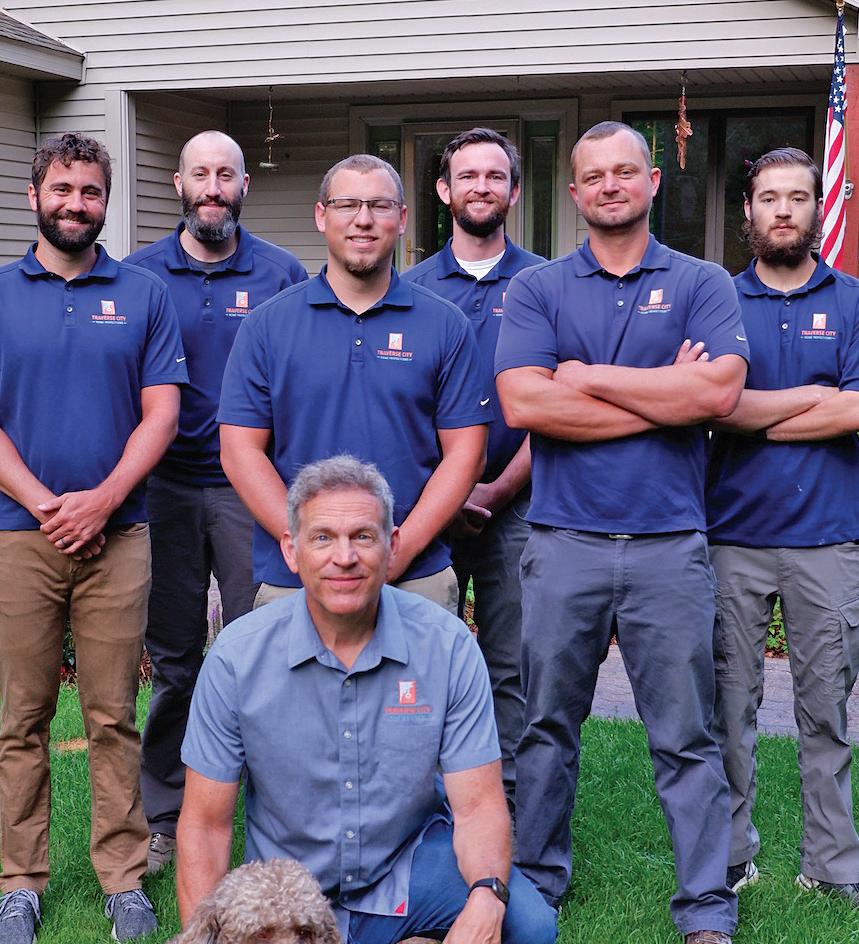
“The house needed too much work,” she said. “So we didn’t get a ton of offers because of that.”
When an offer for $400,000 came in, it was from buyers shopping under their budget, with plans to use their extra money to add a second bathroom to bring it up to par.
Old homes come with new costs
Those under-budget buyers may become more prevalent as all buyers become more aware that the costs of owning an “antique” home don’t end when they get the keys.
“If the home is in town, we always ask about the sewer line,” said Timothy Evans, owner of Traverse City Home Inspections, which performs 1,500 to 2,000 inspections each year.
Evans explains that in-city homes are typically on municipal sewer lines, but before 1980 those lines were made of terra cotta which are prone to root damage. When that happens, homeowners are on the hook for repairing the part of the line that runs from the home to the city’s connection point, even when that point happens to be under pavement or sidewalk.
“Traverse City doesn’t pay for it. The municipality doesn’t,” he said. “You would have to pay to have it dug up.”
The cost can reach $10,000 or more.
“That’s an extreme example,” said Evans, “but it does happen.”
Mostly though, Evans is nicking these homes for things like poor insulation.
“Fifty years ago, people didn’t understand the importance of insulation,” he said, and single pane windows – both of which can be a drain on energy costs during the winter.
When inspectors like Evans find issues, contractors like Chandler Novotny are hired to tackle them. Novotny is vice president of operations at Northshore Exteriors, and estimates that 5-10% of his

business comes from downtown Traverse City. One of the most common issues he sees in the city’s oldest homes are roof repairs done haphazardly compared to today’s standards.
Novotny has seen up to five layers of roof sheathing on some city homes.
“Which, structurally speaking, is actually dangerous,” he said.
“It’s still real competitive … it’s harder for the locals, still.”
- Barb Krueger, Realtor, Berkshire Hathaway
He recommends that unless it’s a recent build, in-town buyers should plan for roof repair costs starting around $70 per square foot, or closer to $90 for steep-pitched roofs, which are especially common in antique homes.
But, these homes aren’t all money pits. While Krueger cautions her clients not to skip inspections, even in a competitive market, she’s quick to add that many older homes in Traverse City are in good shape, especially the ones that have gone through the cycle of being bought, updated and put back on the market in the last decade.
Though that cycle has driven up the cost of city inventory, it’s also the thing that makes it a worthy investment. Evans agrees.
While “it’s a range,” said Evans, most


of the city’s older homes have been well cared for.
“It doesn’t matter if it’s an old home or if it’s a new home. It’s how people treat the house, how they maintain it,” he said.
TC is still out of reach for most local buyers
Traverse City’s buyer mix may be broad, but there’s one segment struggling to make gains. Many longtime locals hoping to make a move into town are hedged out by economical barriers. With the city’s lowest-cost homes still hovering around a $350,000 asking price, buyers earning the county’s median income –just under $80,000 – are priced out by as much as 47%.
“It’s still real competitive … it’s harder for the locals still,” said Krueger.
But there are signs it may get easier for those born and raised Up North to finally get a chance at in-town homeownership. The frenzied bidding wars are fewer and cash is no longer the only king as lenders adapt their financing to be equally attractive to sellers.
“The market adjusted to all those cash offers, and lenders got more creative so that it would give non-cash people a little better [chance],” she said.
The fully underwritten pre-approval is becoming commonplace and it’s as strong as a cash offer, she notes. Inventory is also increasing, however slightly, thanks in part to the city’s sprawl beyond the numbered blocks surrounding Front Street. And with the expansion of the NoBo District and new business and condominium developments popping up around it, Krueger is seeing a boon just south of 8th Street: Carver, Centre and Hannah, once overlooked, are gaining interest from homebuyers.
“I’ve seen the biggest increase in that area probably in my 14 years than I’ve seen other places,” Krueger said.
Medical Office Building For Sale! - 11,486 Sq/Ft. Main Level is 6,187 Sq/Ft. Walkout Lower Level is 5,299 Sq/Ft and Features a Large Open Area w/Picture Windows providing lots of natural light. Excellent for Physical Therapy, Patient Assessments, Gym Related Activities! Current tenant (month to month) is utilizing the lower level (some lab space), and approx. 2/3's of the main floor. The owner is using approx. 1/3 of main floor & shared common areas. Owner leaseback is negotiable or buyer could use the entire building if needed. Many individual offices of various sizes. Close to Munson Hospital surrounded by a variety of Medical Practices. Virtual tour
Medical Office Building For Sale! - 11,486 Sq/Ft. Main Level is 6,187 Sq/Ft. Walkout Lower Level is 5,299 Sq/Ft and Features a Large Open Area w/Picture Windows providing lots of natural light. Excellent for Physical Therapy, Patient Assessments, Gym Related Activities! Current tenant (month to month) is utilizing the lower level (some lab space), and approx. 2/3's of the main floor. The owner is using approx. 1/3 of the main floor & shared common areas. Owner leaseback is negotiable or buyer could use the entire building if needed. Many individual offices of various sizes. Close to Munson Hospital surrounded by a variety of Medical Practices. Virtual tour Online –MLS# 1919691 - $1,499,000.
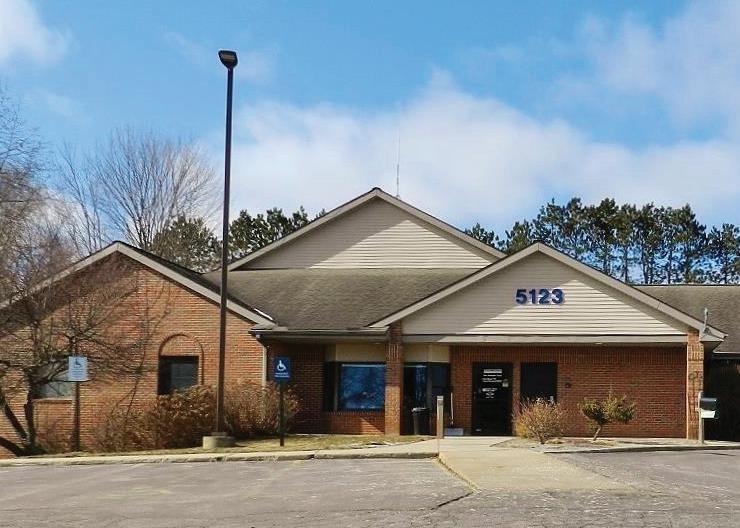



& Plumbed w/ New Drainfield, & Security System. MLS# 1922900 $459,900.

Business, etc. etc. US-31 Highway Frontage & Exposure for Signage on Building. Improvements include 3 phase electric in both buildings - Paved & Plumbed w/ New Drainfield, & Security System. MLS# 1922900 $459,900.
or Cleaning Business, etc. etc. US-31 Highway Frontage & Exposure for Signage on Building. Improvements include 3 phase electric in both buildings - Paved & Plumbed w/ New Drainfield, & Security System. MLS# 1922900 $459,900.

Area w/Picture Windows providing lots of natural light. Excellent for Physical Therapy, Patient As sessments, Gym Related Activities! Current ten ant (month to month) is utilizing the lower level (some lab space), and approx. 2/3's of the main floor. The owner is using approx. 1/3 of the main floor & shared common areas. Owner leaseback is negotiable or buyer could use the entire build ing if needed. Many individual offices of various sizes. Close to Munson Hospital surrounded by a variety of Medical Practices. Virtual tour Online –MLS# 1919691 - $1,499,000. RETAIL/OFFICE



By Rick Haglund
Boiled down, community banking is about collecting deposits and lending them out to people and businesses.
But a type of cryptocurrency known as a stablecoin could upend that relationship, threatening the stability of smaller banks and credit unions that are the economic lifeblood of the communities they serve.
“It’s too early to think of this as an extinction-level event, but it’s certainly something that community bankers, customers and the communities that banks serve should be concerned about,” said Norm Plumstead, president and CEO of Honor Bank in Traverse City.
Andy Kempf, president and CEO of 4Front Credit Union in Traverse City, concurs. Stablecoins, he said, could roil “the financial industry as we’ve known it for centuries.”
A stablecoin is a type of cryptocurrency pegged to the value of another asset, usually





the U.S. dollar. It’s considered “stable” because its value does not fluctuate like other volatile cryptocurrencies, such as Bitcoins.
Stablecoins could soon become a significant competitor to hard currency, the result of sweeping cryptocurrency legislation recently passed by Congress.
President Donald Trump, who has become an enthusiastic supporter of cryptocurrency and a player in that arena, signed the legislation July 18.
The “Genius Act” was passed by the Senate in June and by the House on July 17. The act sets up a regulatory framework for stablecoins that some fear could lead to a massive shift of bank deposits to non-bank businesses such as Walmart and Amazon, both of which are planning to offer stablecoins.
Amazon, for example, might offer 5% discounts on all purchases and faster shipping to those paying with its coin, Plumstead wrote in a recent LinkedIn piece.
“It doesn’t look like banking. But it acts like it,” Plumstead wrote. “And people respond to incentives. If the rewards are good enough, people will shift their money.”
Jim Perry, a Kalamazoo-based community bank consultant, says these big retailers and other non-bank companies will no doubt take on some of the powers that have long been the province of government-regulated banks under the Genius Act.
“All of a sudden we’ve got a Walmart coin and instead of depositing your check at a community bank, you give it to Walmart,” he said.
That would not only threaten the deposits of community banks and credit unions. A major deposit loss would cripple the lending ability of these financial institutions, which are a critical source of financing for small businesses and farmers in places like the Grand Traverse region.
Citing figures from a recent FDIC survey on small business lending, Plumstead said community banks make near 60% of small
“My major concern is that the ease of use in transferring funds with stablecoins opens up the system for bad actors. In a millisecond funds can be transferred from here to Romania.”
– Andy Kempf, President and CEO, 4Front Credit Union
business loans and do more than 80% of agricultural lending. A community bank generally has less than $10 billion in assets.
“We need a stable source of funding for loans, and that comes from deposits,” Plumstead said.
Genius Act supporters say the landmark legislation brings needed regulatory safeguards to a $265 billion stablecoin market that Citigroup analysts say could swell to $3.7 trillion in just five years.
A regulated stablecoin industry will expand consumer choices in financial products, supporters say. Analysts say it will also aid the United States in competing in the fast-growing global cryptocurrency arena.
“Generally speaking, the U.S. is behind the curve in how we think about crypto and digital currency,” Perry said.
Critics say the Genius Act doesn’t go far enough to protect consumers and the banking system. Consumers Reports said the act lacks consumer protections found in traditional banking, including deposit insurance and limitations on liability for


unauthorized transactions. And the act doesn’t give state and federal regulatory agencies enough authority to protect consumers, the publication said.
The act also could broaden the use of stablecoins in cross-border financial transfers, something that worries Kempf.
“My major concern is that the ease of use in transferring funds with stablecoins opens up the system for bad actors,” he said. “In a millisecond funds can be transferred from here to Romania.”
Several other local community bankers say they’re watching the implementation of the stablecoin legislation but aren’t panicking over it.
State Savings Bank spokesman Doug Zernow says the Frankfort-based bank believes it’s “far too early to speculate” on the act’s impact.
Sid Van Slyke, senior vice president of Ludington-based West Shore Bank, which has a Traverse City office, says his bank hasn’t taken a hit on deposits from payment apps such as Venmo and said he hopes “it stays that way” in the new

cryptocurrency environment.
But Perry says community banks need to plan for a new financial model that will disrupt the way they’ve long done business.
“If stablecoins become widespread, it could be the death knell for some of the small institutions that haven’t leaned into the digital age completely,” he said.
Stablecoins have mostly been used for transactions related to the cryptocurrency market. But they are now likely to be used more broadly for business and consumer payments.
That could result in credit and debit cards “going away” with the billions of dollars in fees banks and credit unions earn from those cards, Kempf said.
4Front executives have been discussing potential effects of the stablecoin act and have brought in experts to advise them.
“Nobody fully understands what the impact is going to be,” he said.
But Kempf believes stablecoins will be transformative. He points to earlier innovations in banking such as automated


Atlanta - ATL
Boston - BOS
Charlotte - CLT
Chicago - ORD
Dallas/Fort Worth - DFW
Denver - DEN
Detroit - DTW
Fort Lauderdale - FLL
Houston - IAH
Minneapolis - MSP
Newark - EWR
New Haven - HVN
New York - LaGuardia - LGA
Orlando/Sanford - SFB
Philadelphia - PHL
Phoenix/Mesa - AZA
Punta Gorda - PGD
Tampa/St. Pete - PIE
Washington DC - Dulles - IAD
Washington DC - Reagan - DCA
Cherry Capital Airport






teller machines and online banking that some in the industry thought would never catch on but have become core services.
“This is the future of the financial industry,” he said about stablecoins.
But the options for smaller banks and credit unions to play in the fast-emerging cryptocurrency market may be limited. They will likely soon be competing with big banks, including J.P. Morgan Chase, Bank of America and Citigroup that are already planning to offer their own stablecoins.
Plumstead says rules needed for implementation of the Genius Act must tailor stablecoin regulation for community banks. And he says the Federal Reserve master account, which allows banks to process payments to others in the financial system, must be restricted to entities “subject to full bank-like regulation.”
That may not be enough to keep small banks afloat. Perry predicts there will be “waves of consolidations” as community banks are forced to sell to larger institutions.
“Unless community banks understand the how business model changing, it’s going to be problematic for them,” he said.
Kempf says his credit union is working on it.
“In the end, we have to do what’s best for the consumer,” he said. “We at 4Front like stability, but we’re aware the world is changing.”
“If stablecoins become widespread, it could be the death knell for some of the small institutions that haven’t leaned into the digital age completely.”
– Jim Perry, Community Bank Consultant, Kalamazoo

• A stablecoin is a digital currency pegged to the value of another asset, often the dollar. They are designed to hold a steady value. One stablecoin typically equals one dollar.
• Stablecoins have mostly been used to park profits from other types of cryptocurrencies, according to Bloomberg News. They generally have not been used for buying goods and services.
• The Genius Act sets up a regulatory framework that is likely to vault stablecoins in the mainstream of personal and business finance.

• The act requires stablecoin issuers to maintain reserves for their outstanding stablecoins on a dollar-to-dollar basis. The reserves must be in highly liquid assets such as U.S. currencies and short-term Treasury bills.
• Supporters say the Genius Act will lead to innovations benefiting financial consumers. They say it will also help level the playing field with other countries that rapidly adopting cryptocurrency structures.
• Critics say the act does not adequately protect consumers and could lead to government bailouts of failed stablecoin issuers.

Nursing is a calling. It’s knowing comfort is more than kindness— it’s the bridge between treatment and healing. It’s the quiet promise we carry inside. To care deeply. To act swiftly. To stand beside you and those you love. Easing pain, while soothing hearts.

By Rebecca Teahen, columnist
Like many of you, I’ve grown up loving the land here in northern Michigan – whether it’s a family farm, a cottage tucked into the woods or a stretch of waterfront that holds generations of memories. These places shape our life stories. While we all wish these summer days would never end, our time with these special places is indeed finite. The land will outlive us all, and eventually every family must ask: How will we pass this place on –or is it time to let go?
Whether you choose to keep, sell, or re-imagine your family property, thoughtful planning and professional guidance can help ensure the decisions you make protect your legacy, preserve relationships and support your financial future.
First, I want to recognize that decisions about family land are deeply emotional. These properties hold memories, family history and priceless natural features, but they can also become burdensome.
Perhaps the maintenance is becoming overwhelming, or the carrying costs are no longer sustainable. Maybe the next generation simply isn’t interested in using the property the way you have in the past. These can be difficult truths to face, but opening up the conversation often leads to solutions that honor both the past and the future.
The emotional value of your land is real, and must be considered alongside its financial implications. When assessing what your property means to your family’s future, there are several financial dimensions to consider alongside your goals: Production value: Does the land generate income through agriculture, timber, or rental? Are there development rights that can be sold?
Tax planning value: Could gifting or donating the land, or placing a conservation easement on it, play a role in your overall financial and tax strategy?
Development potential: Would sub-

dividing or selling part of the property better align with your financial and legacy goals than selling it in full?
Market value: If you are considering a sale, it’s essential to obtain a qualified appraisal. For most families, real estate is one of the most significant assets they own. Relying on tax assessments or family lore can lead to costly mistakes. Remember to factor in potential capital gains taxes and transaction costs as well.
Re-affirming your multi-generational commitment to these special places can be powerful. For families who wish to keep the property, long-term stewardship requires planning, both legal and financial. You’ll want to ensure:
• The ownership structure is appropriate and up to date (individual, joint, trust, LLC, etc.).
• Your estate plan clearly reflects your wishes and prepares the next generation for their roles.
• Funds are available for ongoing maintenance, taxes and other costs.
If multiple family members will be involved, open communication is key. Who will be responsible for upkeep? How will expenses be shared? What happens if someone wants out?
These questions can be tough to navigate, especially when emotions run high. Bringing in a financial advisor, estate attorney, or neutral third party can help facilitate productive conversations.
Once you’ve confirmed these essential puzzle pieces are in place, you may want to consider whether there are other experts who could help you manage the land from a natural resources perspective. Reach out to your local conservation district to get started. You may discover
a newfound passion for native plantings, small scale agriculture or find a partner to help manage a larger farm.
Selling family land can feel like closing a chapter, but it can also mark the beginning of a new one. Done thoughtfully, a sale can offer financial freedom, reduce stress, and allow for new opportunities, such as:
• Creating education funds for children or grandchildren
• Supporting a more comfortable retirement
• Making a philanthropic gift that honors your family’s values
In some cases, partnering with a land conservancy can allow the land and your family’s legacy to be preserved while still transitioning ownership.
If you choose to sell, be sure to work with trusted professionals to manage the sale, navigate tax implications and invest the proceeds in alignment with your goals. With good planning, the proceeds from a land sale may be able to provide financial support for your family for generations; creating the financial freedom you hadn’t imagined in the past.
What feels right today may not feel the same way 10 years from now. That’s why it’s so important to keep the conversation going – with your family, and with your financial and estate planning team. Whether your future includes sunny days at the cottage or new adventures made possible from the sale of your real estate, your family’s story continues. Legacy isn’t just about holding on – it’s
about moving forward with care, clarity, and purpose.
With open hearts and trusted advisors on your team, your legacy can continue to grow – rooted not just in the land itself, but in the thoughtful choices you make for those who come next.
Rebecca Teahen, CIMA® is a financial advisor with Baird Incorporated, located in Traverse City and serving clients nationwide. She specializes in generational wealth planning, estate strategy and helping families make wise decisions about their most meaningful assets. The information offered is provided to you for informational purposes only. Robert W. Baird & Co. Incorporated is not a legal or tax services provider and you are strongly encouraged to seek the advice of the appropriate professional advisors before taking any action.
• What does this property mean to our family – emotionally, historically and financially?
• Who is currently using the property, and how might that change in the coming years?
• Are we prepared for the ongoing costs and responsibilities of maintaining this property?
• If we sell the property, what could the proceeds help us achieve?
• What structures (legal or financial) need to be in place to support our decision?
• How do we want future generations to remember and honor this legacy?
• Do we need help from professional advisors to facilitate this conversation and potential future transactions?







By Craig Manning
Thirty-six percent: As of last year, that’s how much of the U.S. labor force is made up by workers from the millennial generation. Another 18% hail from Generation Z, compared to just 15% (and rapidly declining) from the once-dominant Baby Boomer generation. (Generation X, for the record, clocks in at second place, with 31% of the workforce.)
Taken together, these numbers mean that a whopping 54% of America’s workforce consists of people under the age of 45.
You’d never know it from talking to financial planners.
“We have an average client age of 68,” said Rebecca Teahen, a financial advisor at Traverse City’s Rivard Teahen Wheatley Group, which is part of Baird Private Wealth Management.
“Almost our entire client base is 55 or older,” concurred Marc Hudson of Hudson Retirement Clarified, another
Local financial advisors weigh in
local financial planning and retirement planning agency. Hudson otherwise declined to comment for this article, stating that he and his partners “probably aren’t the best resource for the younger
the IRS so you keep more of your money.”
While that message seems like it would be a slam dunk for people in the middle of their careers and in the midst of raising families, though, Tanas falls into the same
“Out of the hundreds of people I talk to, I only have a handful of folks that are in their 20s and are even considering anything with finance.”
– Jonathan Tanas, Executive Broker, Cambridge Brokers
generation,” given their predominantly older clientele.
Jonathan Tanas, the executive broker at Traverse City’s Cambridge Brokers, proclaims on his LinkedIn page that his job is to “help the middle class protect, grow, and preserve their wealth by outsmarting
boat as both Teahen and Hudson. When asked what percentage of his clientele fits into the under-40 bracket, he gives the answer quickly: “less than 10%.”
These bits of anecdotal evidence aren’t the exception in the United States; they’re the rule. Over and over again, the statis-
tics show that, while millennials are in the peak of their working and income-producing years, many of them are not saving, not investing and not planning for retirement – at least not in the way that conventional wisdom says they should be.
It’s been like this for a while: Back in 2018, a study from the National Institute on Retirement Security found that two-thirds of working millennials had nothing at all saved for retirement. For reference, the millennial generation is typically defined as anyone born between the years of 1981 and 1996, meaning all millennials were in their 30s by 2018, and the oldest members of the cohort were turning 37.
The statistics were slightly more encouraging coming out of a 2024 GOBankingRates survey, but only slightly. That study found that about a third of people across a trio of younger workforce age brackets – 18-24, 25-34, and 35-44 – still had nothing saved for their retirement years. The ones who had started saving, meanwhile,
mostly hadn’t saved much: Only about 20% of the 25-34 and 35-44 cohorts had more than $100,000 saved, and less than 8% of 18-24-year-olds had surpassed that savings mark.
Asked about the slow savings progress of many younger Americans, Tanas points to two factors he thinks are causing the problem.
“I still think the main issue is that finance is not taught in school,” Tanas told the TCBN . “You would have to go get a finance major or a business major to learn anything in school about any degree of macroeconomics, microeconomics, and investing, even though those things would be beneficial and practical for anyone to learn in high school or early college.”
The result, Tanas argues, is that every generation is having to learn financial literacy on its own, often by making mistakes or missing important steps along the way. That means slower progress toward savings goals in younger years, and it might also explain why Traverse City’s financial advisors spend almost all of their time working with older demographics.
“Out of the hundreds of people I talk to, I only have a handful of folks that are in their 20s and are even considering anything with finance,” Tanas said.
The other factor Tanas thinks is driving the dearth of finance-focused thinking among younger people is an adherence to
“I think information about personal finance is more accessible than it was 20 years ago. People can learn online. They have access to tools online. There is some risk to that, but I do hope that, long-term, it means more and more young people are saving
and learning about investment options and being proactive.”
– Rebecca Teahen, Financial Advisor, Rivard Teahen Wheatley Group
an outdated life path, which he says has left many 20-somethings and 30-somethings feeling more than a little disenchanted about their economic prospects.
“As a culture, we’re still operating on a 1960s/1970s mindset in this country where it says, ‘Go to school, get an education, and then go get a good job, buy a house, maybe raise a few kids, and you’re done.’ But there are a growing number of people in our country, across all cultural groups and age demographics, who are recognizing that path as a failure,” Tanas said. “We’re living in a post-industrial age. We’ve now entered into a digital age


of how money is made, and everything is shifting. But for the folks who are still pushing or pursuing that old 1960s or 1970s mindset, they can’t catch up to what’s actually happening now in the economy in the United States.”
That broader cultural reckoning point has certainly been bandied about as the culprit behind a new kind of financial despair that has set in among millennials and other younger cohorts.
“Some Millennials and Gen Z have hit an ‘apocalyptic’ phase in which they don’t see the point in saving for the future,” proclaimed a 2022 Business Insider

Those articles cited the unique mix of economic woes that millennials in particular have faced in their lifetimes – including a massive recession that hit just as many of them were entering the workforce, a global pandemic that ground the economy to a halt, skyrocketing college costs and corresponding student loan debt, mass post-pandemic inflation, wages that have failed to keep pace with that inflation, and a housing shortage. And that’s without even mentioning more













existential threats like climate change, global political upheaval, wars, and the rise of artificial intelligence.
Combined, these challenges seem to have left many younger people skeptical or outright distrustful of conventional wisdom around saving money for retirement. Speaking to the New York Times for the aforementioned article, numerous millennial and Gen-Z professionals talked enthusiastically about their decisions to give up on frugality and future-focused thinking, with the reasons ranging from “financial nihilism” (“Houses are just so unaffordable. I don’t even know if that’s worth my time and energy at all,” one source said) to apocalyptic dread (“I’m not going to deprive myself some of the comforts of life now for a future that feels like it could be ripped away from me at any moment,” another told the Times).
Teahen sympathizes with those viewpoints, but is urging young people to think about retirement anyway – regardless of how far off or outright unachievable it seems.
“I think all of us have to balance our long-term priorities or goals with our near-term priorities and needs,” she said. “Because time marches on. When we’re young, we might feel like we can procrastinate and delay saving for retirement and not prioritize that. I get it; I have
three young kids, and a lot of expenses that eat up our monthly budget. But if we don’t prioritize that long-term saving at an achievable level, we’re going to get closer to that retirement age and not have options – and not have time to catch up on what we should have done 20 years earlier.”
Tanas agrees, telling the Business News that his top tip to younger clients is to “take responsibility for your soul.” Because of the stressors of the economy and the world at large, Tanas explains that an increasing number of people are falling into “emotional spending” patterns as a coping mechanism, as a distraction, or even as an act of defiance. While that strategy might seem satisfying in the short run, Tanas is trying to caution clients or would-be clients – especially disenchanted younger ones – about where that path leads.
“People spend a lot of money to avoid stress, but then it just gets them into more stress. It compounds,” Tanas explained. “A lot of people, they just get stuck, and they ruminate in their stress and their depression about their finances, and they don’t tackle or acknowledge the reason why they got into that in the first place. I know it might sound weird to hear a financial advisor say ‘take responsibility for your soul,’ but by looking at the soul a little bit, and understanding that habitual spending, we
can put together a roadmap for how to walk anybody out of debt within a certain time frame – and in a way that gives them the confidence to keep going.”
Teahen, for her part, has some optimism that young people are saving money, even if most financial advisors aren’t seeing them as clients just yet.
“I don’t know if you saw the recent article in the New York Times, but it said that Gen Z is actually outpacing prior generations in terms of their retirement savings,” Teahen said, citing a June 28, 2025 article titled “Gen Z, It Turns Out, Is Great at Saving for Retirement.” The story specifically notes that members Gen Z, or those born between 1997 and 2012, are “contributing to their 401(k)s much earlier than millennials did,” and that young women from the cohort are being particularly “aggressive” about their savings.
“It’s new data, new numbers, but it’s saying that Gen Z are ahead of the game,” Teahen continued. “There are a couple possible reasons that were presented in the story. One is that a new law went into effect that requires employers to follow an opt-out model instead of opt-in. So, if there is an employer retirement plan, all employees are automatically opted into that, unless they say, ‘No, I don’t want to be a part of it.’ So that’s just automatically enrolling presumably younger employees into

the retirement plan where they had not been automatically enrolled in the past, and therefore years would go by and they weren’t saving. That’s a big change. And then I also just think information about personal finance is more accessible than it was 20 years ago. People can learn online. They have access to tools online. There is some risk to that, but I do hope that long term, it means more and more young people are saving and learning about investment options and being proactive. So, I see some glimmers of hope.”







By Renee Sovis, columnist
As I sit at my keyboard in early July, the nonprofit world is facing significant uncertainty, upheaval and fear. Signed into law on July 4, the “One Big Beautiful Bill Act” has left many questions about its true ramifications.
Early drafts of the bill proposed raising excise taxes on private foundations, which would have reduced the funds available for grantmaking to support charitable nonprofits. The charitable deduction for individual donors was also threatened, sparking fears of declining individual giving. While these specific provisions were ultimately removed from the final bill, it still includes cuts to essential programs such as Medicaid and SNAP – reductions that will be felt most deeply by our communities’ most vulnerable members. Add to this the whiplash from shifting tariffs and broader federal funding uncertainty, and you have nonprofits on a genuine roller-coaster of emotions, with fears that are anything but unfounded.
Of course, you’re reading this in August. I hope by now the sector has a clearer, steadier path forward, one filled with sunshine and optimism. But if, as seems more likely, the uncertainty persists, I want to offer a plea: Now more than ever, those who have the means should step up to support our nonprofit community.
First, and perhaps most obviously, when nonprofits struggle to deliver their services, the people who rely on them suffer most. The sector includes food pantries, child welfare organizations, veterans’ services, youth development programs and so much more. The Grand Traverse Regional Community Foundation recently surveyed local nonprofits and found that 55% receive federal funding, which accounts for roughly 19% of their budgets. When these federal programs are cut, the family relying on the food pantry, or the child in foster care waiting for a loving home simply doesn’t receive the care they deserve.
Furthermore, the economy doesn’t just affect nonprofits – nonprofits support our economy in return. According to the U.S. Bureau of Labor Statistics, nonprof-

its account for 10.4% of private-sector employment in Michigan. That means the livelihood of roughly one in every 10 private-sector workers in our community depends on the health of the nonprofit sector. When nonprofits face funding threats, those employees may worry about their jobs and reduce local spending as they prepare for (or weather) the storm. In contrast, a healthy nonprofit ecosystem supports an engaged workforce that spends locally and contributes to a vibrant, resilient economy.
Thus, traditional philanthropists and those with means must step up to provide a safety net when our community’s most vulnerable members are at risk. Even when federal funding is reliable, it is rarely easily replaced by charitable giving alone. It often comes with complex applications, strict reporting requirements and time-consuming administration. Flexible, unrestricted gifts – of any amount, but especially from major donors – allow nonprofits to prepare for uncertainty while continuing to offer their essential services. Such giving can help fill gaps created by cuts or diversions that would otherwise reduce nonprofits’ capacity to serve.
Of course, this may not be the first plea for increased giving you’ve heard. Donors can experience “giving fatigue” when asked repeatedly for more. Coupled with personal worries about economic
I want to offer a plea: Now more than ever, those who have the means should step up to support our nonprofit community.
uncertainty, a thoughtful philanthropist might rightly wonder if now is the right time, or if it’s in their own best interest. That’s a valid concern, and one many of us are weighing carefully right now. For those in this position, there are alternative giving options worth exploring so that when the time comes, your favorite nonprofits will be shielded against economic uncertainty.
Consider making a bequest or planned gift to ensure the nonprofits closest to
your heart are supported during future times of upheaval. Your wealth advisor can suggest ways to reduce income-tax liability and avoid or defer capital gains taxes. Another option is to direct some of your giving to endowments, helping ensure the organizations you care about can weather any storm in the years to come. If you don’t consider yourself a “major” donor, talk with your favorite nonprofits about other ways to help. You might volunteer, share connections, or offer other unique support only you can give. You can also consider giving to the community foundation, which can pool your gift with others to amplify its impact. Community foundations are uniquely positioned to steward these funds and direct them where they are most needed. While we’re all exhausted by living through “unprecedented times,” the silver lining remains in our collective ability to show up for our community and help ensure its future stays bright.
Renee Sovis is vice president of Detroit- and Traverse City-based Neithercut Philanthropy Advisors and a certified consultant working with multi-generational family foundations.
By Kierstin Gunsberg
It takes money to make money, or so the saying goes. But for solo founders launching a business with limited funds, the process can feel more like a Catch-22. Without established revenue or partners to share the load, many are deemed high-risk by traditional lenders.
So it’s no surprise that 75% of startups are bootstrapped, according to the U.S. Chamber of Commerce, relying on savings or credit cards. That’s a precarious start, especially with the Bureau of Labor and Statistics reporting that nearly a quarter of Michigan businesses fail within their first year.

Don’t take (all of) the money
JESSICA HORNESS
Jessica Horness
Counseling
When Traverse City counselor and psychotherapist Jessie Horness left a nonprofit agency to open her own private practice, she wasn’t looking for a ton of capital.
“I am kind of an atypical business,” she said. “There’s not a lot of overhead there.”
By her calculations, a $5,000 loan would cover everything she needed to start seeing new clients including HIPAA-compliant software, rent for her Front Street office, and a few pieces of furniture to pull the space together. But even that modest dollar amount was hard to come by because, as Horness quickly learned, startup loans at traditional banks are usually offered at a minimum of $50,000 – 10 times more than what she needed or wanted to pay back.
“One of the big difficulties was that I didn’t need a lot of money,” Horness said. “But I also didn’t have any.”
It’s a common paradox for small businesses seeking less than $50,000. Tradi-
tional loans often start at higher amounts and require minimum monthly revenue upwards of five digits to qualify, something many founders don’t have right off the bat because they need funding to get started in the first place.
This is where SBA loans (which are smaller loan amounts backed by the Small Business Administration) and especially micro loans (even smaller dollar amounts) hit the sweet spot for businesses like Horness’s that have little to no inventory or overhead. For her, keeping costs and borrowed capital low was a priority. And it paid off. Within six weeks of securing a micro loan via Venture North and launching Jessica Horness Counseling in 2023, she had a waitlist, and enough gains to start chipping away at that micro loan.
For other mental health professionals considering opening their own private practice, she noted a window of opportunity, though it may be short-lived. Medicaid reimbursement rates are currently up, she explained, but as the recently passed Big Beautiful Bill’s work requirements for Medicaid enrollees take effect in 2027, the coverage loss could impact providers Up North. Over 20% of Grand Traverse County’s population is enrolled in a Medicaid program.
For now, though, Horness said, “You could just start taking Medicaid and you will fill up immediately.”
At Venture North, a community development financial institution (CDFI) serving northwest Michigan, President Laura Galbraith and Resource Development and Communications Specialist Tim Ervin say solo founders make up about two-thirds of the applications they receive.
“While every story is different, the same challenges come up again and again. Underestimating how much capital they’ll need, navigating unpredictable expenses, and learning how to run the back end of a business while also being the business,” they said in a joint statement.
Here, four solo founders share what they’ve learned about getting funding and keeping things afloat once the money starts coming in.
Revisit your business plan often
TYLER VANDEMARK TC Golf Carts
After nearly 15 years of 24/7 shifts as a firefighter and paramedic for Traverse City, Tyler Vandemark was ready to sleep in his own bed again. Meanwhile, he explains, most first responders use their days off to work side hustles. So, he decided to start his own in 2019, buying four used golf carts from a downstate cousin who convinced Vandemark that flipping them for a profit Up North was a sure bet.
That cousin was onto something.
When the carts sold almost immediately on Facebook Marketplace, Vandemark saw a path to retiring –sort of. These days, he’s the full-time owner and operator of TC Golf Carts, a full-service operation offering sales, rentals and repairs.
“We’ve got about 120 carts in our rental fleet currently,” he said, adding that he supplies to weddings, campgrounds and special events everywhere from Ludington to the U.P., and right back at home, too, for the Northwestern Michigan Fair and Interlochen Center for the Arts.
But putting up the money to flip a few carts required a lot less money than scaling up to an entire fleet.
“I’ve purchased 100 or so carts in one year,” he said.
With each cart costing around $8,000, he needed close to $1 million in total capital.
While he had some capital socked away from flipping, selling and renting out the few carts he’d started with, Vandemark turned to a loan for the rest. When it comes to asking for a huge amount of

money, he says a rock-solid business plan is everything.
“It’s just very hard to get any leverage until you get a business plan,” Vandemark said. “You need to have a good business plan and know what you’re talking about … because they’re going to try to tear it apart, look for cracks.”
As for what that plan should include, financial projections and revenue are a must, advises Venture North’s Ervin. That means dissecting figures like how much expenses will total and even how the cost of taking out loans plays into those numbers. He and Galbraith also stress that entrepreneurs need to be ready to make tough calls, like adjusting for price increases, simplifying product offerings and managing the seasonality of business in northern Michigan.
“Having a flexible, guiding plan and financial forecast for the business [and] recognizing that plans evolve and should be revisited regularly is key,” they said.

Be ready for a crash course in business
LORI KROGER
“I’m a healthcare provider first and foremost,” said Lori Kroger, a registered nurse who launched her supplement startup Northern Elderberry in 2016 with just seven bottles of syrup that she sold at The Village at Grand Traverse Commons’s winter farmer’s market.
Despite the initial success of her product, Kroger says she’s “not a business person.” Business person or not, her company has continued to scale at a frenetic rate, reaching bigger markets via Amazon and subscriptions, and increasing its output over the last decade by 188% from that first batch of 7 bottles to 240 bottles per batch.
To keep up with the demand for production, Kroger’s turned to microloans to pay for the things that maximize the efficiency of her small family-run business, like upgrades to their berry processing equipment, online fulfillment software and glass-bottle safe shipping supplies – a cost that isn’t static thanks to tariffs and supply-chain snags.
Of what surprised her most while applying for funding, Kroger says it was requests for her personal financial statements.
“I was surprised they didn’t take the business as the business. They also wanted all of my stuff in there,” said Kroger.
What she didn’t realize then that she does now, is that business loans for solo founders can get uncomfortably personal, with lenders digging personal bank statements, credit history and debt-to-income ratios. Unlike group ventures, the founder’s finances are also the business’s finances. If one goes down, so does the other.

The numbers are always changing
DANA WINOWIECKI In It To Win It
Dana Winowiecki is another health-startup founder who’s spent the last few years honing her business savvy with In It To Win It, her macro-friendly meal prep and fitness service. After informally prepping meals for personal training clients back in 2014, then taking a break to start her family, Winowiecki recently relaunched with a commercial kitchen in

Traverse City’s Aero Park.
A $7,500 microloan gave her the funds she needed to cover industrial cooking equipment, bakeware, and startup costs from inspections to rent, without draining her personal finances. For Winowiecki, who grew up on a farm in Leelanau County, coming up with bi-weekly menus full of fresh seasonal ingredients is instinctual.
But staying afloat when the bulk of her business revolves around groceries (which have seen price increases of over 30% in the last six years) has meant learning to manage inventory and profits less on instinct and more strategically.
“From a business standpoint, that can be a little bit trickier because there is an inconsistency with orders,” she said of her à la carte model where clients can pick and choose which – and how many – meals they want to receive. While some clients might opt for a full menu for weeks on end, others grab just one or two every so often.
“If I have low orders but my cost of goods are higher, then my profit is a little bit lower that week,” she explained.
That unpredictability has sharpened her business math skills. Of a recent launch week, Winowiecki explains that while her cost of goods was pretty high, her profit also doubled with those orders and that she would be able to reuse the non-perishables she’d already purchased toward her orders for the next week, helping her to stay in the black. Unpredictability in the food industry has also caused her to be hesitant to use her net income to pay off her loan sooner than she has to, citing the what-ifs that solo founders like her have to account for – vehicle repairs, equipment failures, and of course, price hikes.
“I never know how much my groceries are going to cost when I’m planning my menu.”
A brighter tomorrow starts here.
Greenleaf Trust is here to help design the future you envision. Our team is exclusively dedicated to providing the highest level of comprehensive wealth management services, trust administration, and retirement plan services. Client relationships begin at $2 million.











By Eric Braund, columnist
those approaching or already in retirement, as numerous tax pitfalls can erode wealth if not carefully managed. Without proper planning, retirees may end up paying more to the IRS than necessary. The most impactful tax strategies are often implemented before claiming Social Security benefits or beginning required minimum distributions (RMDs) since both are taxed as ordinary income and can push individuals into higher tax brackets.
To maximize tax strategies, it’s wise to approach tax planning as a multi-year endeavor. The goal here is not only to lower taxes in the short term, but throughout the retirement years and afterward.
Prior to retirement, take advantage of accumulation-efficient tax strategies, including:
• Maximize your retirement contributions: In 2025, 401(k) and other employer retirement plans allow an additional “catch-up” contribution of $7,500 on top of the normal $23,000 payroll deferral maximum. Those aged 60-63 may also contribute an additional $3,750 as a “super catch-up.”
• Open and invest in a health savings account (HSA): An HSA offers triple-tax advantages for future medical expenses. Contributions are income-tax-deductible, growth in the account is tax-deferred and distributions for qualified medical expenses are tax-free.
Be “tax-aware” in all aspects of your finances year-round, not just at tax time.
Optimize tax efficiency in your taxable investment accounts.
• Utilize low-cost, tax-efficient exchange-traded funds and mutual funds.
• Minimize trading that may generate

high-tax short-term investment gains within taxable accounts.
• Use tax-loss harvesting strategies to lower capital gains tax liability each year and consider tax-effective income investments, such as municipal bonds, for your taxable portfolios.
• If your AGI is high enough, all investment income above a certain limit will be subject to an additional 3.8% Medicare surcharge as well. Another reason to coordinate tax planning within your investments.
Roth IRA conversions are a powerful tax strategy for turning part or all of a tax-deferred IRA into a tax-free source of retirement income. You’ll pay income taxes on the amount converted, but once in the Roth, the funds can grow and be withdrawn tax-free either during your lifetime or by your heirs. Because the converted amount is treated as ordinary income, it’s important to plan carefully and coordinate with your overall tax picture. This strategy can be especially beneficial for those retiring early and not yet collecting Social Security benefits.
Be Mindful of Medicare Premium Surcharges
Medicare Part B and D premiums are
based upon prior adjusted gross income (AGI). The added surcharge is called an income-related adjustment amount (IRMAA) and can boost Medicare premiums paid each year. For 2025, the first threshold where the surcharge is assessed is above $106,000 AGI for single taxpayers and $212,000 for married couples. The surcharges increase rapidly thereafter. As an example, the IRMAA more than doubles from $185 per spouse per month for joint filers under $266,000 AGI to $406.90 once the joint AGI reaches $336,000.
Philanthropic strategies remain an effective method to lower taxable income in retirement. Not only might high-income retirees lower their potential IRMAA surcharge, but making deductible charitable bequests can also offset RMDs for traditional IRAs that begin at age 73 and continue for your lifetime afterward. Two common strategies:
• Qualified charitable deductions (QCDs): QCDs are a smart way for retirees who already give to charity to make their donations more tax-efficient. By designating a charitable cause to directly receive your RMD, you receive an immediate tax break that offsets the tax liability of the RMD.
• Donor-advised funds (DAFs): DAFs are charitable investment accounts that allow an immediate tax deduction for contributions of cash or, better yet, appreciated stock. Earnings grow tax-free and the donor may designate which charitable cause will receive donations, either currently or in the future.
Smart tax planning helps retirees keep more of their wealth by reducing unnecessary taxes and avoiding common pitfalls. Coordinating strategies like Roth conversions, tax-efficient investing and charitable giving –especially before claiming Social Security or starting RMDs – can lead to lasting financial benefits throughout retirement.
Eric Braund, CFP®, CRPC® is the founder and CFO at Black Walnut Wealth Management, a fee-only financial advisory firm providing counsel and fiduciary financial services to individuals, families, and private foundations throughout the Traverse City and northern Michigan region. Contact him at (231)421-7711 or visit BlackWalnutWM. com. Braund is an investment advisor representative with Dynamic Wealth Advisors dba Black Walnut Wealth Management. All investment advisory services are offered through Dynamic Wealth Advisors.

By Cortney Danbrook, columnist
Michigan’s strong stance on the control of alcoholic beverages goes back more than 100 years, when it passed a prohibition law nearly three years before the federal government did.
Today it’s hard to believe Michigan initiated a complete ban on the “manufacture, sale, keeping for sale, giving away, bartering, or furnishing” of alcohol, especially given that Michigan’s liquor licensees purchased almost $2 billion worth of spirits alone in 2024. Yet it seems Michigan has always had a complicated relationship with regulating alcohol.
You see, Michigan not only led the charge in the nation to welcome Prohibition, it was also the first state to ratify the 21st Amendment and bring an end to it in 1933. Shortly thereafter, the Michigan Legislature established the Michigan Liquor Control Commission (MLCC) whose mission today is “to make alcoholic beverages available for consumption while protecting the consumer and the general public through regulation of those involved in the sale and distribution of these alcohol beverage products.”
But how do you responsibly regulate alcohol without hindering a business’ ability to conduct operations efficiently?

printing and background check if you are not an existing licensee.
By Craig Manning
Unfortunately, the State of Michigan still struggles with this delicate balance. Whether it is acquiring, transferring or selling a liquor license, Michigan remains very heavy-handed in its regulation of alcoholic beverages.
of quota licenses are permitted to be issued by the MLCC by statute, businesses face strong competition, strict scrutiny and lengthy requirements to obtain the limited number of special statutory licenses issued at the discretion of the MLCC. Of course, there is always the possibility of purchasing a liquor license from an existing licensee, but in northern Michigan be prepared to pay a premium. With limited availability of new on-premises quota licenses from local municipalities, businesses acquiring a license from an existing licensee likely face a six-figure price tag – fueled simply by the economics of supply and demand.
To say it started small would be an understatement.
So says Courtney Lorenz when looking back on the fledgling days of her business, Cultured Kombucha, which is marking its 10th anniversary this year. Incorporated in March of 2015 and launched into the local farmer’s market two months later, Cultured Kombucha was producing 10-15 gallons a week for that entire first summer, and selling out every bit of it at the weekly markets.
“I went to our first farmer’s market with 5 gallons of kombucha, and we sold out in 20 minutes,” Lorenz said. “That whole first market season, it was a scarcity situation. People loved the product; it was very authentic to them.”
Michigan’s Quota System. Acquiring a liquor license should be a simple process, right? Well, not so fast. Michigan utilizes a population-based quota system for liquor licenses, with the number of licenses available in each local governmental unit being determined by the most recent federal census. This equates to approximately one on-premises liquor license per 1,500 residents in any given township, city or village. In many areas, this is enough. However, in Grand Traverse, Leelanau and surrounding counties, most if not all licenses for on-premise consumption of alcohol are in use, which means new businesses looking to acquire a new quota liquor license are out of luck.
By that point, Lorenz had already been home-brewing kombucha “for quite a few
While certain special licenses outside
years,” just for personal use. A fermented and effervescent sweetened tea beverage with ancient roots, kombucha is touted for its ample health benefits – which, thanks to the drink’s probiotic and antioxidant properties, include everything from improved gut health and digestion to stronger immune system responses.
Michigan’s Tangled Regulatory Web. Michigan’s three-tiered system separates control of manufacturers, distributors and retailers, essentially preventing a licensee in one tier from being a licensee in another tier. For example, if you’re a distillery making spirits you can’t also own a convenience store that sells alcohol. This regulatory measure is designed to prevent any one entity from controlling multiple tiers, promoting fair competition and market stability.
“It really helped me heal a lot of my autoimmune issues,” Lorenz said of her homebrewed kombucha. “I had experienced a lot of pain in my 20s, and I had to figure out how to heal holistically, because no one really knew what autoimmune was at that time; no one talked about it. Even today, it’s still very under-described in the marketplace, in terms of educating people.”
The MLCC not only wants to ensure the money used to obtain the liquor license is coming from legitimate sources, it also wants to ensure there is no criminal history related to alcohol and drugs. All these factors will be scrutinized and could result in denial for an applicant. Following the initial intake process, special or unusual circumstances may require additional processing time. In fact, the MLCC estimates it takes approximately six months to complete the application process from submission to approval, with special licenses in many instances taking a year or longer.
of leveraging her home-brewed kombucha into a business didn’t even occur to her for a long time.
Eventually, though, Lorenz came to two realizations.
First, she decided that part of the reason kombucha wasn’t catching on in a big way was that no one was talking enough about the health benefits.
However, securing a liquor license is just the first step. If you are lucky enough to secure a liquor license, prepare yourself for a potentially long road to approval from the MLCC. Regardless of which tier, every applicant, manufacturer, retailer or distributor, individual or entity, must submit detailed background and financial information as well as finger-
Once approved, the MLCC imposes extensive regulatory requirements for maintaining the license and overseeing any changes affecting it or the licensed premises. Adding an outdoor bar or patio? That requires prior approval and an on-site visit from the MLCC. Want to transfer location or even an ownership interest in the entity that owns the liquor license? You guessed it, that too requires approval from the MLCC. These regulations that protect the public and consumers result in a constant struggle for licensees who navigate a multitude of laws and administrative rules to maintain their license and prevent violations.
In fact, Lorenz estimates that, in 2015, “there were maybe only 10 or 15 producers in the entire country” that were focusing specifically on kombucha. The market was so nonexistent that the idea
“I had originally gone to culinary school, and I was working as a pastry chef, and I realized that people were disconnected from their food sources,” she explained. “I knew that I had a passion for educating people about the connections between food and health and wellness. That’s always been a core value for me. Eventually I thought, ‘If [kombucha] is making me happy and healthy and helping me get my body right, I should definitely give that opportunity to others as well.’”
enforcement of alcoholic beverages within the State of Michigan. This “roadmap” of complex laws and administrative rules that governs liquor licensees is comprised of more than 60,000 words, and, like any good set of rules or laws, is always subject to interpretation. The MLCC is made up of five members who are appointed by the governor to serve a four-year term. Ultimately, interpretation and enforcement of all laws and rules governing liquor licenses rests in the hands of these individuals with guidance from Michigan’s Attorney General. As new commissioners are seated, the perspective of the commission on certain issues can change. The result? The commission’s position on a specific rule can change from year to year, leaving licensees scrambling to keep up. So, enter with gratitude on your next visit to one of northern Michigan’s licensed establishments. Not just gratitude for the incredible service they provide, but gratitude for the complex journey these businesses undertake to obtain and maintain their liquor licenses within Michigan’s strict regulatory framework. All so you can enjoy that alcoholic beverage of your choice in this remarkable community we call home.
Subject to Interpretation. Flashback to 1933 when the Michigan Legislature established the MLCC, when the enactment of the Liquor Control Code set forth the powers and duties of the MLCC as well as the framework for licensing, taxation, and
Second, Lorenz decided to bet on herself – and specifically on her belief that kombucha would be more popular if there were better-tasting versions of it on the market.
Cortney Danbrook is an attorney at Danbrook Adams Raymond PLC in Traverse City. She provides specialized counsel to business clients on liquor licensing and regulatory compliance, and advises individuals, families and businesses in the areas of estate and succession planning. She can be reached at (231) 714-0163 or cdanbrook@darlawyers.com.












By Craig Manning
To say it started small would be an understatement.
So says Courtney Lorenz when looking back on the fledgling days of her business, Cultured Kombucha, which is marking its 10th anniversary this year. Incorporated in March of 2015 and launched into the local farmer’s market two months later, Cultured Kombucha was producing 10-15 gallons a week for that entire first summer, and selling out every bit of it at the weekly markets.
“I went to our first farmer’s market with 5 gallons of kombucha, and we sold out in 20 minutes,” Lorenz said. “That whole first market season, it was a scarcity situation. People loved the product; it was very authentic to them.”
By that point, Lorenz had already been home-brewing kombucha “for quite a few
years,” just for personal use. A fermented and effervescent sweetened tea beverage with ancient roots, kombucha is touted for its ample health benefits – which, thanks to the drink’s probiotic and antioxidant properties, include everything from improved gut health and digestion to stronger immune system responses.
“It really helped me heal a lot of my autoimmune issues,” Lorenz said of her homebrewed kombucha. “I had experienced a lot of pain in my 20s, and I had to figure out how to heal holistically, because no one really knew what autoimmune was at that time; no one talked about it. Even today, it’s still very under-described in the marketplace, in terms of educating people.”
In fact, Lorenz estimates that, in 2015, “there were maybe only 10 or 15 producers in the entire country” that were focusing specifically on kombucha. The market was so nonexistent that the idea
of leveraging her home-brewed kombucha into a business didn’t even occur to her for a long time.
Eventually, though, Lorenz came to two realizations.
First, she decided that part of the reason kombucha wasn’t catching on in a big way was that no one was talking enough about the health benefits.
“I had originally gone to culinary school, and I was working as a pastry chef, and I realized that people were disconnected from their food sources,” she explained. “I knew that I had a passion for educating people about the connections between food and health and wellness. That’s always been a core value for me. Eventually I thought, ‘If [kombucha] is making me happy and healthy and helping me get my body right, I should definitely give that opportunity to others as well.’”

Second, Lorenz decided to bet on herself – and specifically on her belief that kombucha would be more popular if there were better-tasting versions of it on the market.
“What I brewed at home was so much better than the store-bought items,” Lorenz said. “One thing that really sets Cultured Kombucha apart in the marketplace is that our base actually tastes good. And most companies will cover up a very average or poor kombucha base with a bunch of flavors, or a bunch of carbonation. From the beginning, we really wanted to focus in and make sure that our base was phenomenal on its own.”
Not that nailing down the perfect recipe was easy. Looking back, Lorenz admits that learning the craft of making the perfect base kombucha “was probably my greatest struggle.”
“I’m certainly happy for producers that are starting now, but man, did they miss those really challenging days,” Lorenz said. “There was no industry back then to help us understand how to get started. My first batch was a massive failure. I still have the notebook; I still have a photo of it. It just did not turn out – and I even had culinary training. It took me a good amount of understanding to get my own recipe corrected, and then learning how to scale it when I started the business was a whole different process. And I was 24 years old; I barely had any life experience under my belt, let alone manufacturing experience.”
Compounding those typical startup challenges was the fact that, when she started Cultured Kombucha, Lorenz didn’t even have a stable housing situation.
“I was going through some pretty big life changes, and I actually lived out of the back of my old, orange Jeep for a couple months on the beach while I was getting started,” she recalled. “I started the first summer with a hot plate and an extension cord and a sink, and that was it. By the end of that summer, I’d bought a four-burner stove off of Craigslist for $75, because that’s what I could afford at the time, and that was a huge deal.”
Cultured Kombucha remained a bootstrapped operation for at least its first five years. During that period, Lorenz hand-filled every bottle of kombucha “off of five-gallon pails with spigots,” and then hand-labeled them all. After a half-decade of that, though, Lorenz “had carpal tunnel so bad that I couldn’t sleep at night” and decided Cultured Kombucha was due for an upgrade: a used two-head bottle filler from eBay. That system cost more to ship to northern Michigan than to buy the actual setup, though Lorenz later learned she’d gotten lucky.
“I found out later it was a $40,000 machine, and the person that sold it to me just had no idea,” she said of the bottle filler. That piece of equipment stayed in rotation until this past year, when Cultured Kombucha finally invested in a brand-new bottling line.
While the first 10 years of Cultured Kombucha have been dotted with milestones – expanding into the current


“I
think kombucha has come into the limelight at the exact right time ... I have never seen so many people waking up daily and choosing their own health and wellness, which I think is just absolutely amazing. It lights me up.”
– Courtney Lorenz, Founder, Cultured Kombucha
taproom facility near Chums Corner in 2018 was a significant moment, as was onboarding with all of Meijer’s Michigan grocery stores in 2022 – Lorenz says many of the biggest breakthroughs have come “in the last two-year period.”
In addition to the new bottling line, recent highlights have included a 2023 grant to expand the production facility, a 2024 brand makeover, and this year, investing in an in-house delivery fleet and
winning a 2025 “Michigan Companies to Watch” award from Michigan Celebrates Small Business.
Cultured Kombucha is also just growing. Speaking to Crain’s Grand Rapids in May, Lorenz said the company had nearly doubled in size in the preceding 18 months. It now serves 600 stores in seven different Midwestern states, has a year-round team of five (plus an extra


four to cover festivals and other seasonal obligations in the summer time), and produces roughly 2,000 gallons of kombucha every week. The days of 15-gallon batches and never-ending scarcity, in other words, are far behind.
Lorenz credits much of the growth to the changing tides of the beverage world. Not only has kombucha found a foothold in the marketplace, but non-alcoholic drinks have taken off in a big way – a shift Lorenz expects will be permanent.
“I think kombucha has come into the limelight at the exact right time,” Lorenz said. “Statistics say 49% of people will
drink less in 2025. The trend is more than Dry January now; it’s more than Sober October. It’s a personal lifestyle choice. I have never seen so many people waking up daily and choosing their own health and wellness, which I think is just absolutely amazing. It lights me up. But I don’t envy the alcohol world right now. You could pay me to invest in it, and I wouldn’t touch it with a 10-foot pole. I think people are waking up to the fact that they can’t put poison into their bodies and assume that their lives are going to maintain the same level of quality.”
While Lorenz says she and her team are focused on the summer rush at the moment, they’ve got a few things on tap for the fall – both to celebrate the 10year anniversary and tee up the next 10 years.
“We’re going to celebrate the anniversary with a big party out at the brewery in September,” Lorenz said – though a specific date or other details for that event haven’t been announced yet.
Cultured Kombucha is also hoping to have two new products rolled out in time for that celebration. The first is kombucha in cans – a change of pace for a business that has only sold its product in bottles and kegs in the past.
“We want kombucha to be able to go even farther with you than it already does,” Lorenz explained. “You can take it on a bike ride. You can take it to the beach. It can match your lifestyle.”
The second new product in the pipeline is a line of water kefir, which Lorenz describes as “another ferment very similar to kombucha, but it doesn’t have the bite. We think people will find it to be a very approachable probiotic beverage.”
Lorenz also teased several new retail partnerships that will be “launching soon,” and said she’s hoping to “start hosting some pop up events in Traverse City soon, for a sober-centric opportunity downtown.”




build located on a
1.25 acre lot in Elmwood Township of Leelanau County - only 10 minutes from downtown Traverse City - with views of West Grand Traverse Bay! This 3 bed/2.5 home combines
efficiency, and thoughtful design and was proudly featured in the 2012 Parade of Homes.

One veteran and one newcomer on the state of the craft beer industry

By Craig Manning
Is the craft beer industry dying? Wind the clock back to last decade and even asking that question would have been outlandish – especially in Traverse City, where breweries proliferated at a rapid rate throughout the entirety of the 2010s. In 2019, the craft beer industry generated nearly $30 billion of revenues in the United States alone, and sold more than 25 million barrels of beer. For those doing the math, that would have equated to roughly one barrel of craft beer for every 13 Americans. Talk about a booming industry.
If the 2010s were a decade of explosive growth for craft beer, though, then the 2020s are proving to be a decade of decline. The COVID-19 pandemic proved particularly dire, with the Brewers Association reporting that craft brewers produced just 23.1 million barrels of craft beer in 2020 – down 9% from the previous year. That year, craft beer’s market share of the overall domestic beer marketplace fell from 13.6% to 12.3% – a tough pill to swallow, considering that the broader U.S. beer market shrank 3% in the first year of the pandemic.
Things aren’t looking much better five years later. In April, the Brewers Association reported that craft brewers in the U.S. had produced 23.1 million barrels of beer in 2024 – the same as in 2020, and down 3.9% year-over-year from 2023. Perhaps more troubling for beer fans and brewers nationwide? 2024
marked “the first year since 2005 that the number of breweries that closed outpaced brewery openings nationwide,” with a total of 529 craft breweries closing their doors.
All these nationwide statistics beg the question about craft beer’s potential demise. Was it a fad all along? Or is there still some life left in this once-vibrant segment of the beverage industry? To get a local perspective, the TCBN touched base with two Traverse City brewers with decidedly different vantage points.
On one end of the spectrum, we have Russell Springsteen, who, as the founder of Right Brain Brewery, is one of northern Michigan’s most senior craft beer experts. Right Brain has been at it since 2007, beating most other TC breweries to the punch by 5-10 years.
On the other end, meet Justin Rivard, a relative newcomer to the local craft beer scene whose new brewery, Nocturnal Bloom Brewing, just opened its doors at the end of July.
A state of the union from Right Brain Brewery
“The last couple of years have been pretty rough,” Springsteen said, when asked about the state of Right Brain and of local craft beer more generally. “There’s been pretty major decline nationwide, but also here. We’re seeing it. We’re seeing it in our pub sales; we’re seeing it in pint sales declining. People just aren’t sitting and drinking as much, or they’re going from brewery to
“I would say package sales and distribution are harder than ever, because you’re getting a lot of national brands that are taking a brand and making it five different flavors and crowding the shelf.”
- Russ Springsteen, Founder, Right Brain Brewery

brewery and having just one drink at each spot. Those trends are spreading it pretty thin [for each individual brewery].”
It’s not just a change in dynamics at the taproom; Springsteen says things are even worse on the distribution front. Right Brain is one of a small handful of local breweries that have historically done well getting their beers on the shelves at major grocery chains like Meijer and Kroger. The business has lost significant ground on that front in recent years, though. Some of the major grocery chains, Springsteen says, will no longer even stock beer unless they ship to all 50 states – a rarity in the craft beer world. Elsewhere, especially in Michigan, more and more shelf space has gone to major players like Founders and
Bell’s, one-time torchbearers in the state’s craft beer scene that, having both sold out to major international owners, are no longer even considered craft breweries by the Brewers Association.
“I would say package sales and distribution are harder than ever, because you’re getting a lot of national brands that are taking a brand and making it five different flavors and crowding the shelf,” Springsteen said.
Examples include popular Michigan beers like the Two Hearted Ale from Bell’s or the All Day IPA from Founders, both of which now exist in half a dozen different variants.
“That’s not by accident,” Springsteen said of the trend. “It’s meant to shove the
little guy off the shelf.”
Compounding the distribution challenge, Springsteen says, is that independent bottle shops and liquor stores aren’t doing the numbers they once did. While those types of retailers are more likely to stock local products or emphasize craft producers, many consumers simply fell out of the habit of visiting those stores during the pandemic.
“That’s one of the big lingering trends I’ve noticed from COVID, is that people stopped shopping at the independent liquor stores,” Springsteen said. “There was a huge decline, and that’s really never come back. People got in the habit of doing their one-stop shopping at grocery stores and big box stores. It was just a total shift in consumer mindset.”
There have been a few glimmers of hope on the distribution side, though, mostly thanks to Springsteen’s willingness to follow market trends while still giving them a Right Brain Brewery spin. That adaptability, he says, has the business “not crushing it, but staying alive” when it comes to finding shelf space out in the market.
“I was asked by distribution to create a new product, and so we’re doing a long drink,” Springsteen said.
A long drink, for reference, is a Finnish cocktail, historically made with gin and grapefruit soda and concocted with higher fluid volume – and lower alcohol strength
– than the typical cocktail. Recently, long drink cocktails have become popular in America thanks to a ready-to-drink canned cocktail version branded simply as The Long Drink. Springsteen “spent a year trying to figure out how make a long drink,” and launched Right Brain’s version in March of this year. The standard edition, called Michigan Long Drink, is made with the traditional grapefruit flavor, while a summertime local version, dubbed Traverse City Long Drink, swaps in cherry flavors.
“The Traverse City Long Drink, we limited that to just 600 cases statewide, and I sold 50 cases through our pub during Cherry Festival week. We never do that on any one brand,” Springsteen said. “We’re not bringing [the cherry version] back until next summer, but we’ll work on a couple more flavors of long drink, or maybe some other ready-to-drink cocktails, too. We just need to try to do some different things like that, because I think that’s where trends are going.”
Beyond COVID, Springsteen mostly chalks up the decline of craft beer to a generational shift. Gen-Z and other younger consumers, he says, “aren’t drinking much craft beer” compared to the generational cohorts that were dominant in the market a decade ago. Those older cohorts, meanwhile, may still like craft beer, but seem to be drinking less of it. Combine those dynamics, and things
“I really want to play with local ingredients and relationships, like taking spices and botanicals and other things that are maybe less commonly found and doing creative spins on beers, creative spins on seltzers.”
- Justin Rivard, Founder, Nocturnal Bloom Brewing
look way different than they did in the 2010s – although, on a rainy summer day, Springsteen says Right Brain’s taproom can still look as busy as it ever did in the craft beer heyday.
“I have an advantage on a rainy day,” Springsteen said, when asked whether Right Brain’s cavernous taproom on 16th Street has started to feel a bit roomy during this period of craft beer contraction. “We do record numbers, because people pile in from the beach and the campgrounds. They know that we have entertainment and we have the space. The Sunday after Cherry Festival, when it was


raining all day, that was was a near-record Sunday. It was so busy, we couldn’t even keep up. And it was great.”
Nocturnal Bloom Brewing: New kid on the block
While Right Brain has 18 years and counting under its belt, Nocturnal Bloom Brewing at 3344 Cass Rd. could still measure its time as an open-to-the-public business in hours. The brewery – Traverse City’s newest – just celebrated its grand opening on July 30. Despite opening into a much different



















Blain’s
Burkholder
Copy
D
Edson
Ford
Great
Ginop
Merrill
Peninsula
Short’s
Sound
Summit
The






Alper’s
JKB
State
T’Marie
Traverse

craft beer market than the one Springsteen’s brewery came of age during, Nocturnal Bloom owner and brewer Justin Rivard is optimistic about the future. While a newcomer to the local beer scene, Rivard isn’t a newcomer to the beer world in general. A graduate of Traverse City Central High School, Rivard boomeranged back to the area after going to school at Albion College (“for cognitive neuroscience, of all things,” he chuckles) and then putting down roots in Ann Arbor. It was there that Rivard’s brewing journey began.
“I was doing some research work there, and all the while, had gotten jobs in various breweries to make ends meet,” Rivard said of his Ann Arbor chapter. “I kept climbing up in brewing positions, and was just having a lot of fun, and eventually got involved in the actual brewing process.”
Rivard’s resume includes stints at Jolly Pumpkin’s downstate brewery in Dexter, as well as Grizzly Peak Brewing Company in Ann Arbor and Corner Brewery in Ypsilanti. He served as head brewer at the latter “for a couple of years” before he and his now-wife traded the Michigan life for an address in Monterey, California.
“I brewed at a small brewpub out there, called Peter B’s, pretty much up until 2020, when the pandemic hit,” Rivard said. “I decided at that point it was time for a change, and it had become my goal to open my own brewery. So, I moved back to Traverse City, my hometown, sought out some investors, and started working on the Nocturnal Bloom project in 2020.”
While working behind the scenes on the new brewery, Rivard took a job at Great Lakes Malting Company, “doing R&D beers” so that breweries looking to buy malt from Great Lakes Malting could sample the product in beer form. The job, he says, was the perfect way to “get reconnected with the Michigan brewing scene.”
While that scene may not be what it once was, Rivard still thinks it’s plenty strong – and that this slightly more fallow period might actually be the perfect time for beer-loving entrepreneurs to get into the market.
“For one thing, there’s a lot of equip-
ment on the used market,” Rivard said.
“I’m a brewer by trade, and I’m not necessarily made of money or anything, so being able to buy probably two-thirds of my equipment used really helped me by lowering that cost of entry. My brewing system, I think I paid about $15,000 for it. If I had bought that same system new, it would have probably been $55,000 or $60,000.”
Rivard also believes a less crowded and less noisy industry is more conducive to innovation, which he hopes will be a calling card of Nocturnal Bloom.
“I really want to play with local ingredients and relationships, like taking spices and botanicals and other things that are maybe less commonly found and doing creative spins on beers, creative spins on seltzers,” Rivard said. “Maybe that means working with, say, spicebush, or lavender bergamot, or turkey tail mushrooms. I have a smaller brewing system – a single-barrel system – so I can really do some wilder experimentation.”
Rivard is also interested in trying to make craft beer more of an experiential thing – not just coming in for a pint or a brewery tour, but actually getting customers involved in the beer-making operation.
“I’ve considered bringing in home brewers, or catering to bachelor or bachelorette groups, and they could come in and they could make a beer,” Rivard explained. “I like the idea of getting the community involved with the brewing process.”
Overall, Rivard says his focus is on bringing something different to the craft beer marketplace, in hopes that there’s still enough interest in that market for him to make some waves.
“Craft beer isn’t this sexy new thing anymore, so how do you bring people in and get people interested again?” Rivard concluded. “Not long ago, it was like everyone and their uncle wanted to open a brewery. A lot of people did it without much training, and a lot of the beers were substandard, and as a result of that, craft beer lost its luster. But I don’t think the customers are gone; I just think the consumer now is much more savvy to what good beer is. We have to rise to meet the challenge.”





hemming& Wealth Management truly believes in financial planning for life-long fulfillment. Whether you’re dreaming of a forever home, new car, your retirement lifestyle, or a lasting legacy, we’ll help you make purposeful decisions and ensure your financial plan is well-coordinated and effective in reaching your goals.


By Ross Boissoneau
Few industries are as volatile as the restaurant business. According to the National Restaurant Association and various economic studies, between 17% and 30% of restaurants fail in the first year, and up to 60% close in the first three years. Yet some manage to hang on and prosper. What is the secret? For Dave Denison, it was a combination of things: location, capital and listening to what customers wanted. That’s what led Amical – originally La Cuisine Amical – to three decades of success. Though Denison retired in January, Amical continues to this day, now under the ownership of Denison’s longtime general manager Jeffrey Libman.
Denison says being able to secure a location on Front Street was due to the capital investment from his partners, Don Phillips and Judy Sullivan. But it was that last ingredient – listening to his customers – that led to wholesale changes in the way Amical did business, including the restaurant’s layout. When Denison opened in
1994, service was cafeteria-style, with patrons moving through a line as they ordered.
“In the beginning it was a bakery/café that operated for quick service,” he said.
While the cafeteria approach worked for breakfast and lunch, it didn’t for supper.
“We couldn’t attract anyone for dinner. So we changed our [dinner] focus to offer table service,” he said.
In 2000, he dropped breakfast altogether and began offering table service at both lunch and dinner.
He was also able to secure a liquor license and moved the bar to the front of the building. But the biggest change was opening the patio area facing Front Street.
“It really helped with visibility,” said Denison.
Previously people would congregate around the fireplace in the back, and to passersby the restaurant would appear empty.
Denison says that lunch business was less about profit than providing full-time work for staff. The opposite is true across town.
Centre Street Café is open for lunch only, from 11am-3pm Monday through
“You need to be engaged. It’s like people coming into your home. It’s hard to put that into a business plan.”
– Pete Boothroyd, owner, Centre Street Café
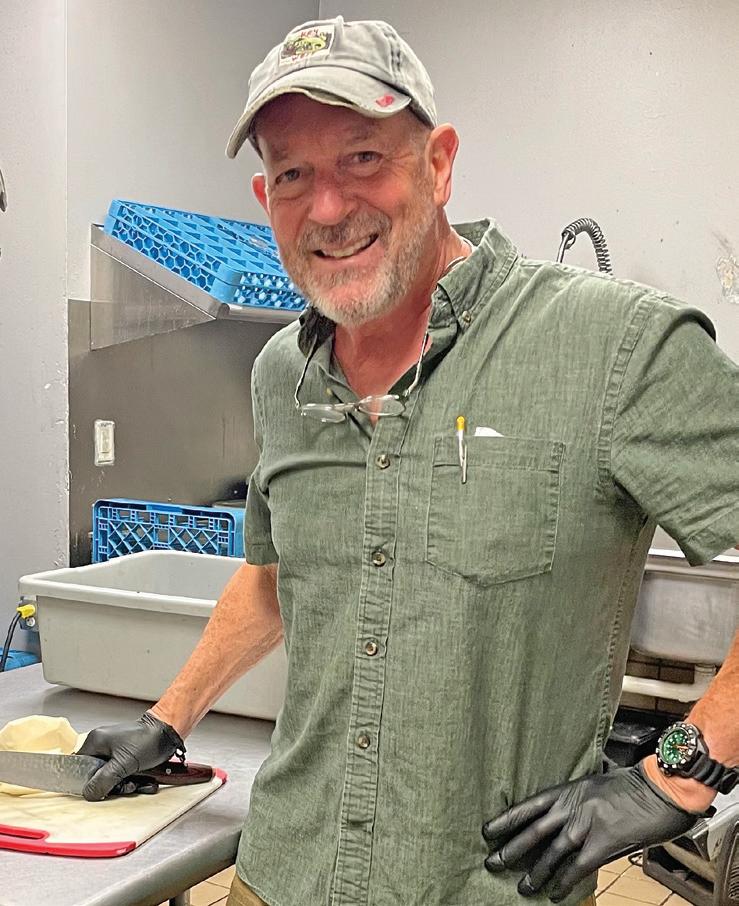
Friday. Owner Pete Boothroyd has overseen the café’s rise from a snack bar at the gym that used to occupy the space to a full-service restaurant.
“The idea of food service in a gym was an anomaly,” admitted Boothroyd, who opened the establishment in 1985. He
saw patrons’ focus on a healthy lifestyle as ready fodder for his healthy snacks, foods and beverages. But only about ten percent of those working out were interested, and when the gym closed down in 2000, he lost even that base.
Boothroyd had realized early on that
he needed to reach beyond gym members and looked to catering as well as attracting people from outside who weren’t coming to the gym. That enticed him to think outside the tried and true.
“You can’t just do the same old and think you’re going to make it,” he said. “Like any art form, you have to evoke and create something that people are surprised by or blown away by, a new experience.”
So, he began to create unique sandwiches, combining the standard fare of meats and cheeses with ingredients like crushed smoked almonds, artichoke hearts and radish sprouts, plus espresso cheddar, tomato-basil feta, cherry-chardonnay chutney and more.
“We want to create a taste profile that knocks your socks off,” he said.
Denison and Boothroyd agree that creating food people want to eat is critical, but it’s only one part of the business.
“Everybody’s got a recipe,” said Boothroyd.
So, is it just location, capital and good food? Not necessarily. Maybe even not at all – Boothroyd readily admits his location on a side street off Garfield is far from ideal, but after 40 years there he’s not about to move.
Other keys are staffing, owner involvement and consistency.
“You need to be engaged,” Boothroyd said. “It’s like people coming into your
home. It’s hard to put that into a business plan.”
While Amical and Centre Street Café have withstood the test of time, it’s too early to tell if Nittolo’s Little Italy will make it.
The cozy establishment in the Breaker Building in downtown Traverse City has just been open a couple months. Owner Eric Nittolo is bullish on its chances.
“I love the location. The overall response has been unbelievable,” he said. “We’re doing 200-300 (meals) a day.”
He said consistency is a key, as is providing the best, most creative food he can at a price point that allows for profit and customer satisfaction. He is using the same recipes as at his flagship operation, Nittolo’s Seafood and Pizza in Lake Leelanau, but reducing portion sizes and prices.
“People are tired of not getting value,” he said.
Nittolo has also responded to what he finds customers asking for.
“You need to change and evolve every year without shocking the customers,” he said, adding that he has changed the “entire” wine list at both restaurants.
Even some of those restaurants that get good reviews on social media and other accolades may not last. Simon Joseph opened Roaming Harvest, Traverse City’s first food truck, in 2012. From there he moved on to the brick-and-mortar Harvest, then the noodle shop Gai -



“It was almost a decade. I’m married to a CPA, and the numbers don’t lie.”
– Simon Joseph, former restaurateur, Roaming Harvest/Harvest/Gaijin
jin. All were well-received, but by late 2019 Joseph had closed his restaurants and was out of the business altogether.
Looking back, he said he’s proud of what he and his teams accomplished. He says that creating food is an art, but in the end the art has to pay the bills.
“I think we did some really great [things],” Joseph said. “I think we left a mark behind us that has allowed [other] people to do it their way.”
Ultimately, however, he needed to close the doors.
“It was almost a decade. I’m married to a CPA, and the numbers don’t lie,” he said. “You have to make decisions that are the right ones.”
Joseph doesn’t see himself returning to the food scene. He’s now creating custom kitchen cabinetry – another art. But he remains enthusiastic about food and about those still in the industry.
“I love restaurants. Centre Street still blows me away,” he said. “I gave it [the restaurant business] as much as I was willing to.”





Discover a one-of-a-kind Northern Michigan estate offering over 1,000 feet of private frontage on two lakes, nestled on 16 acres with panoramic water views, a custom 3,165 sq-ft home, pool, gym, hot tub, and even a 6-site private campground for family & friends. Perfectly located between TC and Lake Michigan, this legacy retreat blends luxury, recreation, and serenity like no other.





When
Because
TVC’s highest passenger day ever and the latest expansion timeline
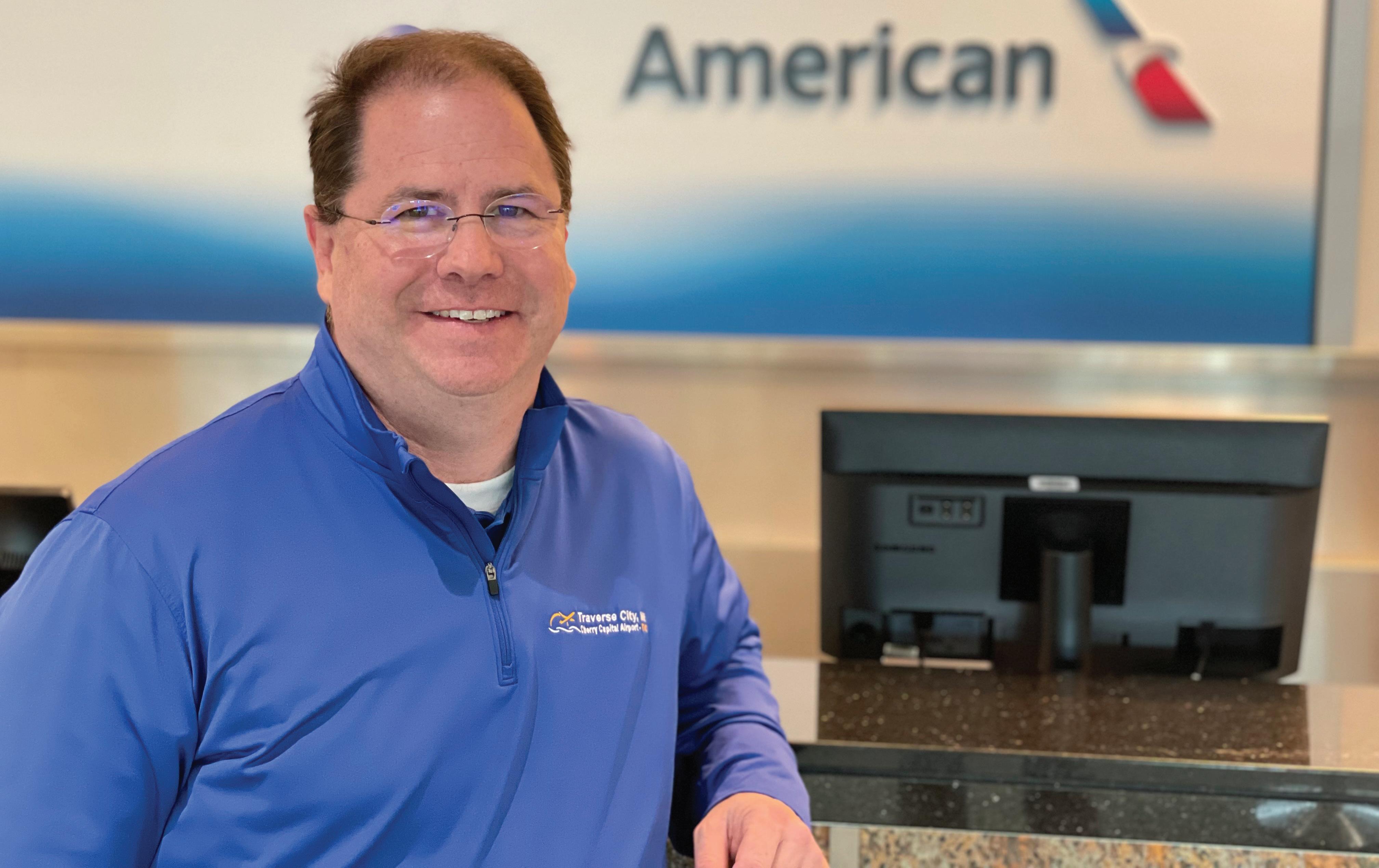
The TCBN does its quarterly check-in with Cherry Capital Airport Executive Director Kevin Klein, who takes a moment out of his busiest season ever to talk air travel, expansion and more.
TCBN: Obvious question this time of year: How’s summer at the airport?
Klein: It is awesome. Very busy but people have been great. It’s just been a lot of fun. We set records on July 5 and 6 for passenger throughput at the TSA passenger checkpoint. Our highest day ever was 3,992 passengers on Sunday, July 6 and Saturday, July 5 was 3,846 passengers. The third busiest day was June 22 at 3,254.
TCBN: Are the dates you’ll be busiest pretty predictable on the calendar?
Klein: They’re pretty predictable. When you look back at 2024, our highest day ever was August 11 at 3,168 passengers, but the next were July 6 and 7. So predictable in terms of peak days, yes. Fridays and Sundays tend to be busiest, and then dates that correlate with Interlochen [camper] changeovers and key Horse Show events.
TCBN: I assume the year-over-year numbers are up as well?
Klein: I just got our June 2025 numbers today. We’re up about 17.5% yearover-year, so the records keep falling.
TCBN: But we can’t keep setting records, right? I mean, it’s not sustainable.
Klein: Not sustainable with our current facilities, no, which is why we’re expanding.
TCBN: And where do or would you see the pinch points first in terms of having problems with too much growth?
Klein: The pinch points would be first at the security checkpoint and then for screening prior to checking bags and loading bags. So what we did in 2022 with TSA was expanded our checkpoint to three lanes, which reduced our overall wait times. Even on our busiest day, July 6, our precheck line was 4.6 minutes versus all airports’ regular line average wait of seven minutes. Our longest wait on that busiest day was less than 20 minutes.
TCBN: And how is the labor situation overall? Typically that’s a challenge in summer.
Klein: It’s been pretty good this year. I still think the airlines are looking for more people, but this year has probably been the best year in the last four years for them, though they’re still looking.
TCBN: And any rental cars left? That’s been another issue in summer.
Klein: Plenty of cars. They’ve been great. The car rental business is booming, so we expanded and added another 200 spots to our ‘ready’ lot off the building. They were turning that lot over six to eight times a day, so we’ve now minimized that turnover.
TCBN: Parking?
Klein: It’s also been great. We’ve had the typical balance in summer of locals and visitors traveling in. But we are working on an economy lot, with construction starting after Labor Day, about a $3 million project. Hopefully that will be ready to go by the February parking lot crunch time. A shuttle will be added for that lot.
TCBN: We’ve heard there are still issues with Uber and rideshare services?
Klein: Well, with BATA we had a pilot program and that has been well received. So I think that will continue to grow and will lead to discussions about how long to extend that into the night. We have a great relationship with them. On the Uber/Lyft side, not much has changed. We haven’t seen many more drivers there. We have seen an uptick in people using the Turo app, though. Cabs have been normal, hotel shuttles all normal.
TCBN: Excited to hear how the expansion is coming along.
Klein: We just received our 50% design documents, which is great. We are right on track. That will allow our construction manager to put bids to it, which will happen probably in August, so we can finalize construction documents after that. All so we can put shovels in the ground as soon as the snow goes away in spring. We’re on track there and on track with grants, so that’s great. We’ll go for federal loan
and bond financing for the remaining $60 million.
TCBN: This expansion is such a unique and complex process. Are you just learning it all on the fly?
Klein: Yes and no. I joined TVC in December 2002, so I landed right in the middle of the construction of this terminal working alongside [predecessor] Steve Cassen.
TCBN: How did this year’s Cherry Fest go for TVC?
Klein: I think it went well operationally. I have to give kudos to Dan Saul here at the airport. He worked with the airlines on the air show to get our flight schedules adjusted. The quote of the day came from Kelly Hudson, the air show air boss, when she turned to Dan 10 minutes to 3pm, and he said we were ready for six more departures and one more arrival before we could do it [the show]. She said, “How many?” They accomplished it all and worked together.
TCBN: And 2026 planning?
Klein: Next year is the 250th anniversary of the USA, so the Blue Angels committed elsewhere. The Cherry Fest also knew they wouldn’t have Air Force Thunderbirds because they were also committed elsewhere. But we’re working with [Cherry Fest] on their shows. It will all depend on what they do. Will they do a night show and a day show? Will there be drones? That would be little to no impact on the airport. We’ll just have to see.












Imagine sitting in a rowboat and wanting to get back to shore. If you just sit there, the wakes from passing boats and the wind could cause you to drift further toward the middle of the lake — not where you want to be. Of course, they might actually move you toward the shore. Who knows?
On the other hand, you could use your paddles. It’s more work, but it’ll increase the possibility of your reaching your destination.
It’s similar with your portfolio. If you neglect it, market activity may cause it to drift away — possibly far away — from where you want it to be.
Take, for example, a portfolio that starts out 60% stocks/40% bonds. If stocks were to have a particularly good year and bonds a bad one, the allocation could shift to, say, 70% stocks/30% bonds without the investor even realizing it. While this portfolio likely has better growth potential than the original, it could also take a bigger hit if stocks, which tend to be more volatile than bonds, turn around and have a bad year.

To help avoid this, you should consider periodically “rebalancing” your portfolio. This involves looking at how you’re diversified across different types of investments and considering selling some investments and buying others when necessary to bring your portfolio back to the asset allocation you originally intended. In the example above, you might think about selling stocks and buying bonds to get to 60%



Fueling Michigan today and tomorrow.
Every day, Michiganders depend on secure, reliable energy to heat their homes, fuel businesses, and power industries. Enbridge proudly delivers 55% of the propane used in Michigan.
We continue to modernize our energy infrastructure and further protect the Straits of Mackinac crossing by investing in the Great Lakes Tunnel.
As a North American integrated energy company, we’ve been delivering the energy the state needs for decades and we’re investing in Michigan communities and infrastructure. It’s how we’re building toward a better tomorrow.
Discover more at enbridge.com/Michigan.




Northwestern Michigan College in Traverse City announces the following:
1 - Diana Fairbanks has been named associate vice president of strategic communications and change initiatives. Fairbanks is helping lead the college’s new strategic change initiative while continuing to oversee public relations, marketing, and communications.
2 - Jody Lundquist was recently selected to fill a vacancy on the Northwestern Michigan College Board of Trustees. Lundquist is chief financial officer and partner at Boomerang Catapult and executive director of Northern Michigan Angels in Traverse City.
3 - Katharine Marvin has been named vice president of colleg e advancement, leading the NMC Foundation, Dennos Museum Center, WNMC Radio, and the International Affairs Forum. Marvin brings a decade of experience at the NMC Foundation to her new role, most recently as director of development & alumni relations. Marvin joined NMC in 2016 as an annual
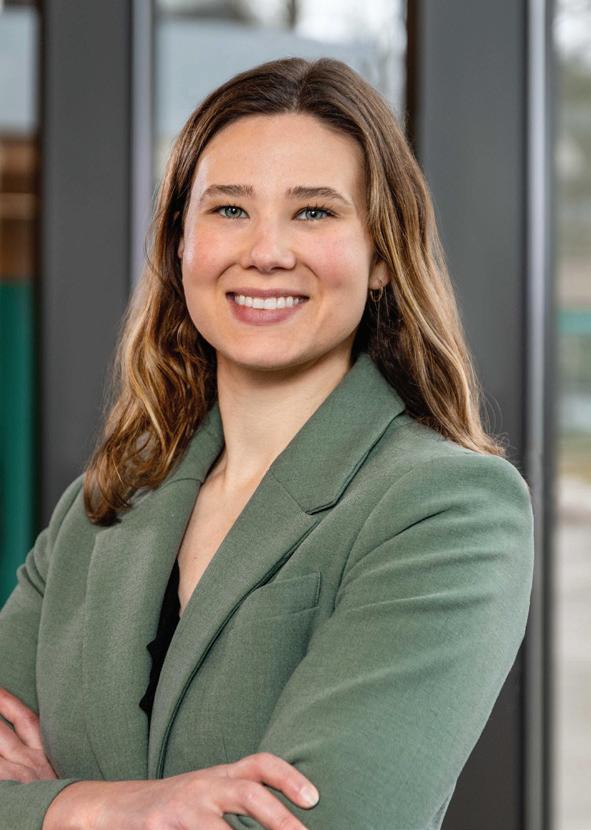
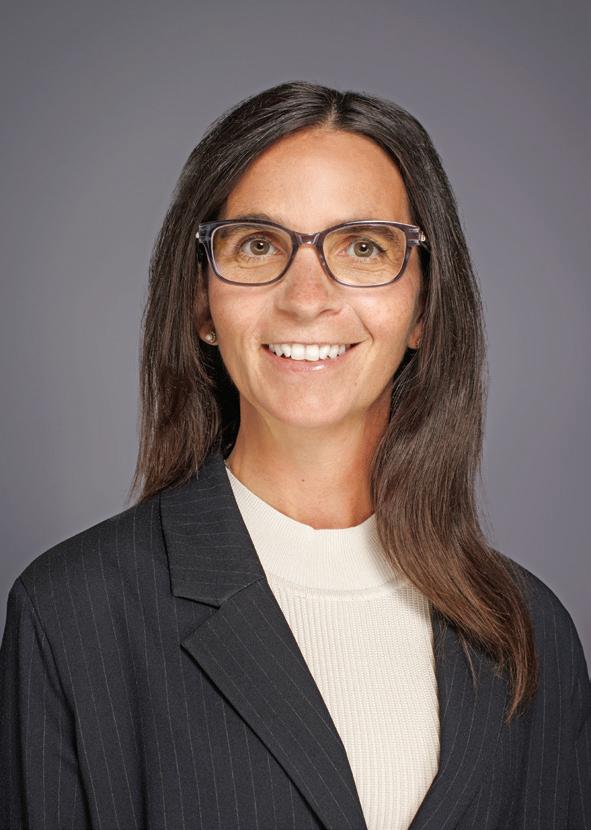
giving specialist. She rose to director of annual giving in 2019, director of development in 2022 and director of development and alumni relations in 2024.
4 - Sylvia Kelly has joined Cardinal Insurance Group in Traverse City as a personal lines sales agent. A licensed property, casualty, and life insurance agent, Kelly has more than 8 years of experience in the insurance industry.
5 - Fletcher Spears IV has been promoted to accounting supervisor at Dennis, Gartland & Neirgarth in Traverse City. Spears joined DGN as a senior accountant in 2023.
6 - Alycia Dzierwa , family nurse practitioner, recently joined Cherry Bend Family Care in Traverse City. Her practice emphasizes a holistic and evidence-based


approach to medicine, focusing on the well-being of individuals and families across all ages.
7 - Lisa Lord is the n ew director of clinical quality at Copper Ridge Surgery Center in Traverse City. Lord brings more than nine years of surgical nursing experience from Munson Medical Center. Her background includes roles as surgical services quality coordinator and certification as an operating room circulator, as well as a quality engineer in the automotive industry.
8 - Carly Nicholas has joined the Traverse City Downtown Development Authority as communications and special projects coordinator. Nicholas brings a background in communications, and event planning and coordination to her new role supporting initiatives focused on placemaking and growing downtown businesses, event planning and community engagement.
Please send Newsmakers by the 10th of the month to news@tcbusinessnews.com






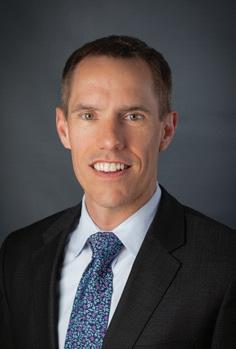




































Northern Michigan’s housing stock and the opportunity to remodel

Traverse City’s neighborhoods are rich with character, and aging homes. With a median build year of 1960, most homes here have passed the half-century mark. While they exude charm, they also demand attention. For homeowners, retirees, and the skilled trades, this aging stock presents both a challenge and a golden opportunity to remodel, revitalize, and future-proof homes across the region.
The Backstory Behind the Beams
Traverse City’s aging housing stock isn’t by accident. Many of its neighborhoods, like the Central and Boardman Historic Districts, feature homes dating back to the late 1800s and early 1900s. A post-WWII construction boom brought in a wave of mid-century builds during the 1950s–70s, which now make up the bulk of residential housing.
The Cost of Time
Older homes come with a unique set of challenges:
• Deferred maintenance: Roofing, plumbing, wiring, and insulation often need major upgrades.
• Energy inefficiency: Outdated heating, cooling, and appliances lead to higher utility bills.
• Accessibility concerns: With over 22% of the county’s population over 65, many homes aren’t set up for “aging in place.”
• Affordability pressure: Rising repair costs and property values create challenges for low-to-moderate income households.
Remodeling: A Smart Investment
Despite the obstacles, remodeling makes sense for both financial and lifestyle reasons:
• Home value boost: With the median home price in northern Michigan rising, $400,000+ in Grand Traverse County as of mid-2025 (prices vary widely by county), strategic renovations, kitchens, energy-efficient upgrades, and modern mechanicals, can deliver strong returns.
• Market appeal: Updated homes sell faster in a cooling real estate market where homes now spend an average of 60 days on the market.
• Energy savings: Adding insulation, upgrading windows, and modernizing HVAC systems can reduce utility costs significantly over time.
• Lifestyle benefits: Open layouts, first-floor master suites, and universal design features create long-term livability.
Aging in Place: A Growing Priority
As the region’s population ages, there’s growing demand for homes that support mobility, independence, and health. Simple
updates like grab bars, wider doorways, and zero-step entries make a huge difference. De velopers are also piloting age-in-place housing models that integrate accessibility with comfort and aesthetics.
Organizations like the Home Builders Associa tion of Northwest Michigan and local builders are stepping in to support this movement, blending function with dignity, and creating long-term housing solutions that serve every generation.
Policy Momentum & Public Incentives
Northern Michigan and its partners are embracing strategic revitalization:
• Housing goals in the region’s Housing Plan emphasize rehab for aging housing stock.
• A 2023 Housing North report highlights 4,000+ new and rehabbed units in the pipeline across the region, thanks to tools like tax in crement financing, land banks, and workforce housing incentives.
• Municipality and nonprofit partnerships unlock access to rehab grants and forgivable loans for qualified homeowners.
These efforts are helping to reduce the financial burden for households looking to remodel rather than relocate.
Risks to Watch
• Maintenance costs: Renovation is just the beginning; older homes often carry higher long-term upkeep costs.
• Financing friction: With higher interest rates, some buyers and owners are hesitant to take on renovation loans.

• Cost-burdened households: Many renters and homeowners are already paying 30% or more of their income on housing, limiting flexibility for improvements.
Addressing these concerns means expanding funding access, streamlining permit processes, and providing clear guidance for homeowners and contractors alike.
Moving Forward: A Regional Opportunity
Northern Michigan has a rare chance to lead by example, preserving its architectural character while modernizing with energy efficiency, accessibility, and long-term housing security front and center. There’s abundant opportunity here, and a paycheck for skilled hands ready to remake, restore, and re-energize these vintage gems.



The Home Builders Association of Northwest Michigan is here to help you navigate the process of building your dream home. Our members possess the local expertise and experience to guide you through every step, from initial planning to final construction. Learn more at hbagta.com/.







YMCA Family Membership, Downtown TC $100 shopping spree, TC Phil tickets, TC Roller Derby tickets
Jimmy Johns sandwiches and snacks, Grand Traverse Pie Co. pies, lawn games, park tours and more — $10 entry
Wednesday August 6th • 5-7pm Civic Center Park & Amphitheater






2ND
Associates





3RD
Britten,
Brodeur
Cornerstone
Independent
Jimmy
Northern
Summit
Susan
TruNorth
























MSUFCU is the Unlimited Cash Back Credit Union! When you open an MSUFCU Checking account, you’ll unlock exclusive member benefits, financial education, and digital tools like CashBack+!
Whether you’re buying a new laptop or stopping for a coffee on your way to work, you’ll earn up to 20% cash back with CashBack+.
It’s as easy as 1-2-3:
1. Purchase a digital gift card using your MSUFCU Checking account
2. Receive instant cash back
3. Decide how to use your cash back What will you earn cash back on? msufcu.org/cashbackplus
After selecting and purchasing a gift card, it will be sent to your email for use. Please note some gift card purchases are subject to a 1–3-day hold. Gift card purchases are final and non-refundable. For more information, visit msufcu.org/cashbackplus. Gift cards are not a product of MSUFCU and each merchant’s gift card terms of use may vary. For more information, visit prizeout.com/terms. For your security, do not provide gift card or redemption information to any unknown parties. For more information on gift card scams, please see our blog post. To use CashBack+ in your mobile app, please update your app to version 3.45 or newer on your iOS or Android device from the App Store or Google Play. There is no charge to download the MSUFCU Mobile app. However, data and connectivity fees from your mobile service provider may apply. Please contact your mobile service provider for more information. Some features may be available for MSUFCU members only. Not all MSUFCU account types are eligible to use the CashBack+ experience. See your available offers in the MSUFCU Mobile app or ComputerLine.® If you do not see a way to access CashBack+ in your mobile app or on ComputerLine, please reach out to us at 800-678-4968 or at msufcu.org/contact. Federally insured by NCUA.

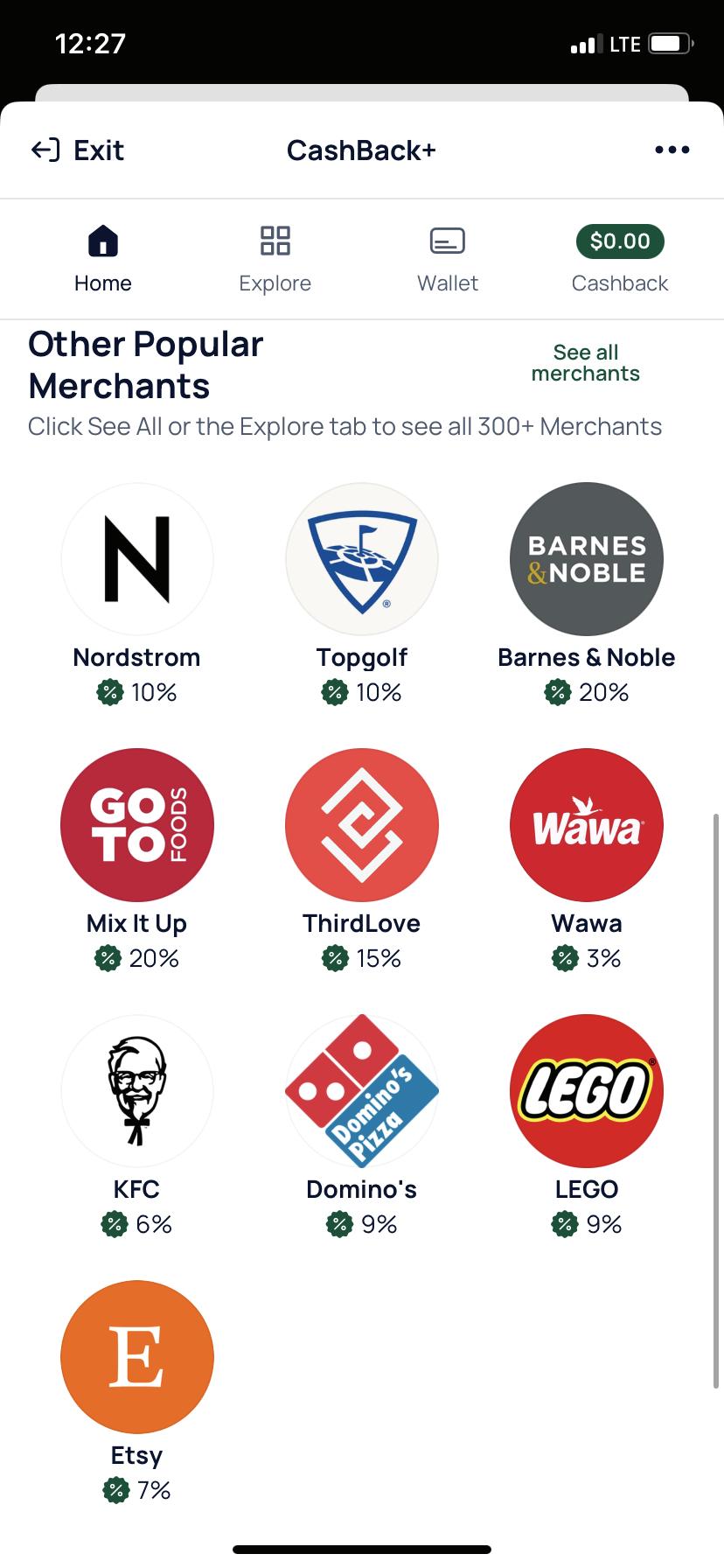











Family-owned & operated
Free in-home design consultation
Free professional measuring services
Certified installers
Over 45 years experience